#oh to have seen him play Rochester on stage
Explore tagged Tumblr posts
Photo
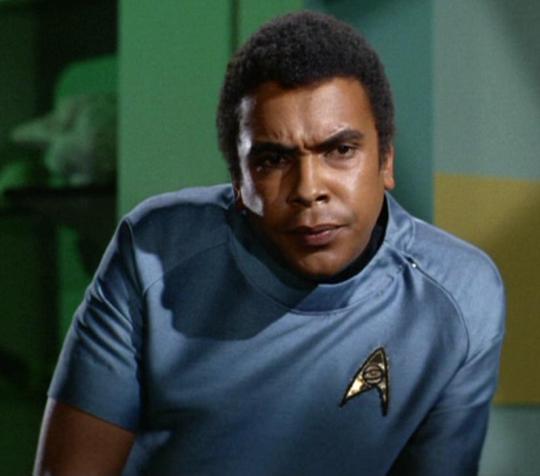
Look at that deadly serious face. Would you believe there are two amusing stories involving this gentleman? One from a scene involving his character, the other involving the actor behind the scenes.
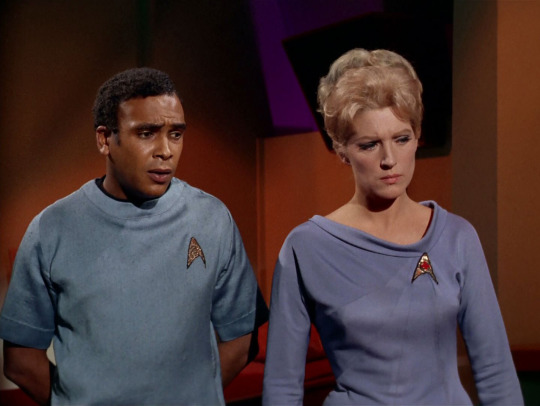
The idea to bring in a doctor specifically trained in Vulcan medicine was a good one. But we were not introduced to Dr. M’Benga until halfway through the second season in an episode titled “A Private Little War.” It is because of his expertise that we know all those bizarre life scan readings are merely a sign that Spock is concentrating his efforts on healing the severe gunshot wound he had received on the planet.
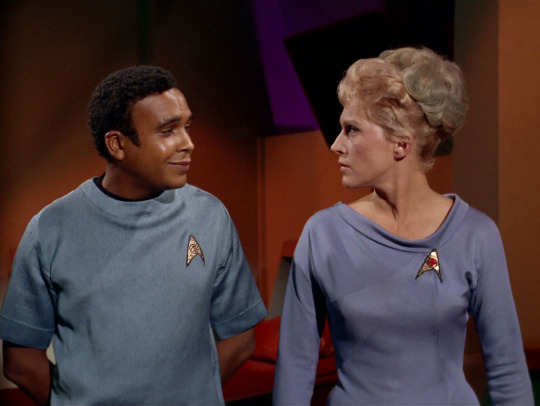
Up until this point, we have only seen the stern, serious side of M’Benga. But we find in this scene that he has a wicked sense of humor (and an excellent sense of observation). He informs Nurse Chapel that Spock has been conscious enough the entire time and most likely even realized Christine had been holding his hand earlier. And then you see this little grin as poor Nurse Chapel looks mortified and more than a little miffed.
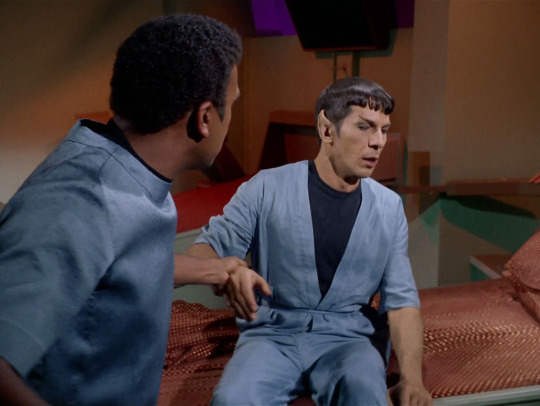
There is one other scene that is not exactly amusing in itself, but has an side story that is. This is the scene where Dr. M’Benga gives Christine explicit instructions about what to do if Spock shows any signs of consciousness. But when the time comes and Spock commands her to hit him as hard as she can, Christine just can’t do more than a weak slap. Then Scotty enters and when he sees what is happening, pulls her away. It’s up to Dr. M’Benga to bring Spock back to full consciousness.
Which he proceeds to do by pulling his arm back... and delivering a wallop of a slap that even Scotty would be proud of.
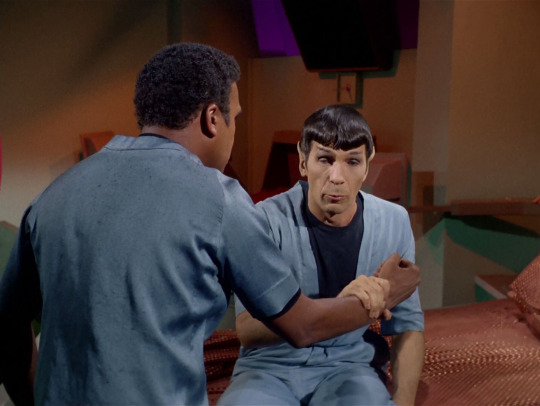
And which Spock calmly deems quite sufficient. But Leonard Nimoy was actually pretty irate just after the slap. The filming of this episode was already behind. While the crew set up for this scene, Leonard Nimoy pulled the actor Booker Bradshaw aside and told him he didn’t want to have to reshoot the scene (because he had a paid appearance scheduled that evening). So according to Bradshaw, Nimoy told him no stage slap - to give it everything he had. So... when the time came, Booker Bradshaw wound up and delivered a slap so hard, it knocked Leonard off his feet. And the Vulcan ears off Leonard. Which sent the stage crew and everyone else on the set into peals of laughter but Nimoy did not see the humor at all. Bradshaw said to his dismay, the star was quite angry and made it clear that this time, he better make it a stage slap.
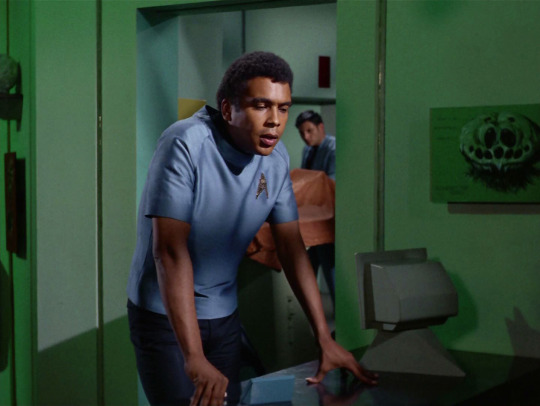
We see him one more time in “That Which Survives” when he is asked to find the reason Ensign Wyatt died. Dr. M’Benga replies that Dr. Sanchez (in the background) is already performing the autopsy and promises to report the results to Mr. Spock as soon as he knows them.
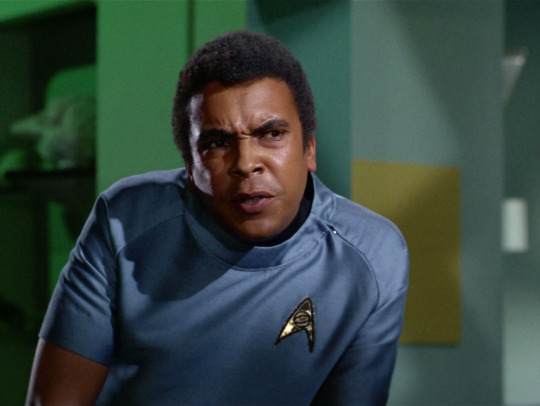
Later, Dr. M’Benga’s expression demonstrates his exasperation at not being able to give Mr. Spock an explanation for Wyatt’s cause of death, which Dr. Sanchez had established as cellular disruption. And that’s the last time we see Dr. M’Benga. Memory Alpha seems to think that Dr. M’Benga was meant to be there from the start and that M’Boya was simply a misspelling of his name in that first draft. Yet according David Tilotta in an article on StarTrek.com, Dr. M’Benga was not added to the cast of “That Which Survives” until a few days before filming. In the very beginning, the doctor’s name was given as M’Boya. Then as the script revisions progressed, the character of Dr. M’Boya was dropped and his lines given to Nurse Christine Chapel.. But Marc Cushman’s These Are the Voyages: Season Two backs up what David Tillota wrote, saying that one of the researchers from Kellam de Forest suggested to Fred Freiberger that the name should be changed to M’Benga on September 13th. However, he makes no mention of the previous change of M’Boya to Nurse Chapel doing the autopsy. Still, it does seem likely someone would have realized there was no need to create a new doctor when Dr. M’Benga had already been established as highly regarded by his CMO. Story Editor Arthur Singer turned in a final draft on September 20th and page revisions were added on the 21st. Once Fred Freiberger made a few more changes and created the revised final draft dated September 24th and the page revisions were inserted the next day. Just in time for the first day of production which again backs up David Tilotta’s assertion that Dr. M’Benga was close to a last minute addition/revision.
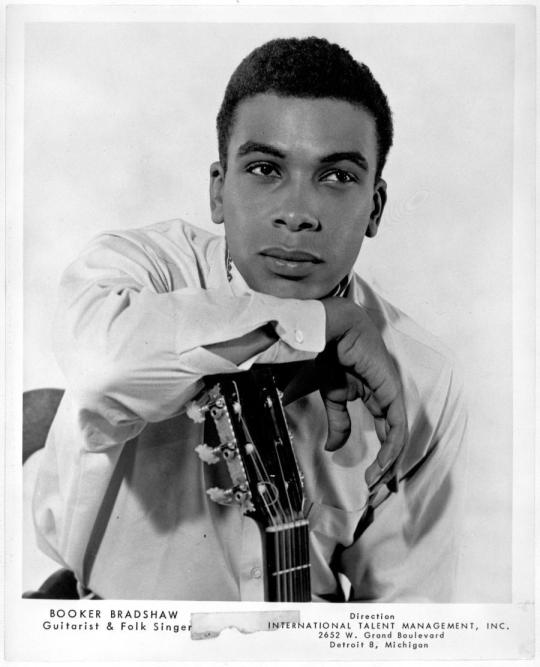
Dr. M’Benga was played by Booker T. Bradshaw of Richmond, Virginia. Bradshaw’s background is quite impressive. After working at his father’s life insurance company, Booker decided this was not the life for him and entered Harvard University. During his junior year he appeared on the Ted Mack Amateur Hour as a folk singer. Not only did he win three times, but he made it to the finals at Madison Square Garden. Booker did return to graduate from Harvard in 1962 with the intention of becoming a lawyer. Fate intervened in the form of a Fellowship at the Royal Academy of Dramatic Arts in London but not before he had performed at Carnegie Hall. Bradshaw did receive an honors certificate for his time at the Academy of Dramatic Arts which he completed by touring England with his Academy students as part of a Shakespeare repertory theater. *photo credit: http://quod.lib.umich.edu/b/bhl/x-hs8414/hs8414
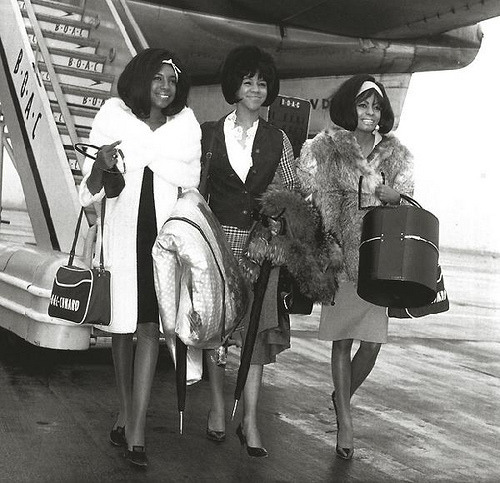
After finishing the Royal Academy of Dramatic Arts, you would think Booker would head straight into the acting world, wouldn’t you? Oh, he had done some stage plays in Harvard and a few other venues, but another opportunity arose. Bradshaw’s connection in the music world lead him to working for Motown Records in Detroit as their international manager. He specifically arranged the European tours of both the Supremes and the Temptations. According to several stories he could speak anywhere from three to nine languages, depending on the source. Above is a photo of the Supremes as they were about to start their 1965 European tour in London. Not only did Bradshaw serve as their manager but he also did an interview with them that was reprinted here - https://motownjunkies.co.uk/2013/03/02/589
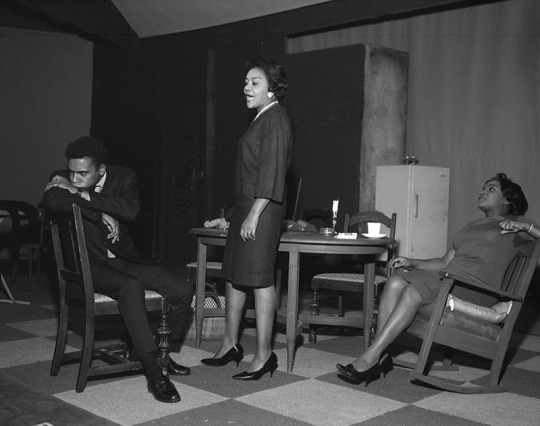
Around 1967, Booker Bradshaw came back to the United States to resume his acting career and joined a repertory theater in Rochester, Michigan run by one of his mentors, John Fernald. Fernald was formerly Head of the Royal Academy of Dramatic Arts. Bradshaw even wrote the lyrics and music for a play produced there titled And People All Around, which was based on the murders of three civil rights workers in Mississippi. He also appeared in several plays at the Ebony Showcase Theater, including Day of Absence and Happy Endings in 1967. One of his co-stars in both plays was Isabel Sanford. Some of you may remember her as Louise Jefferson in The Jeffersons, which ran from 1975-1985. The Ebony Showcase Theater was the first black theater created especially for black audiences in Los Angeles. Above - Booker Bradshaw, Juanita Moore and Isabel Sanford (Louise Jefferson) in Happy Endings. Photo credit - https://filmismemory.wordpress.com/2015/12/29/the-ebony-showcase-theater/

Booker Bradshaw went on to have a very full and successful career in television and film, both as an actor and as a writer. He landed parts on a number of television shows, including several episodes of Tarzan, the Mod Squad, and The F.B.I. In fact, as this newspaper clipping shows (which was actually a press release that appeared in many newspapers across the U.S.), it was thought his role as Special Agent Harry Dane might be a semi-regular one. However, he is only credited with appearing in two episodes. *clipping from p. 35 of The Jackson Sun (Jackson TN), November 7, 1969.
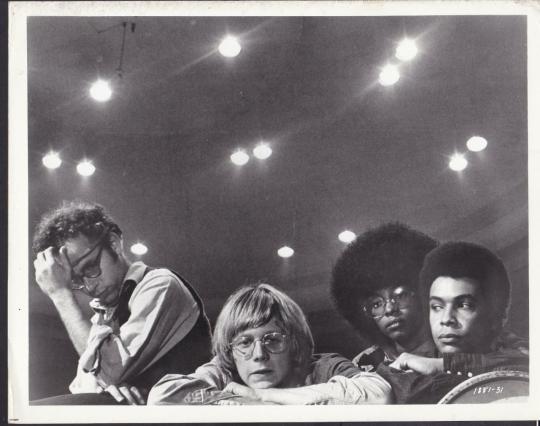
Bradshaw’s movie appearances were fewer, but included two that attained some notice at the time they were released. Above is a publicity photo from The Strawberry Statement (1970) which was loosely based on the Columbia University protests of 1968. He played the character Lucas who is seen on the far right. Fellow Star Trek actress Kim Darby was the female lead named Linda.
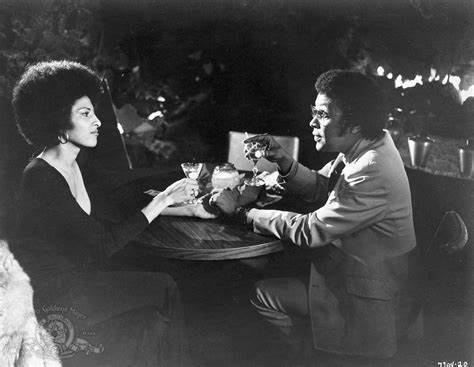
But Booker Bradshaw’s biggest role probably was that of politician Howard Brunswick in Coffy (1973). He was the boyfriend of the title character played by Pam Grier. She played the title character, a nurse who is out to get revenge on the drug dealers who were responsible for the death of her sister. Being a folk singer/media mogul/ theater actor/TV & film actor was evidently not enough. Bradshaw also became a quite accomplished television writer. Between 1973-1976 he and David P. Lewis together wrote scripts for shows like Columbo, Planet of the Apes, and McMillan and Wife. Bradshaw went on to do scripts for Different Strokes, Gimme A Break, and four episodes of The Richard Pryor Show. During the 80s he became a voice actor. Sadly, his impressive career came to an end when he died suddenly of a heart attack in 2003.
#Star Trek TOS#Dr. M'Benga#A Private Little War#That Which Survives#Booker Bradshaw#Booker T.Bradshaw
86 notes
·
View notes
Text
JACK BENNY’S 20th ANNIVERSARY SPECIAL
November 16, 1970

Produced by: Irving Fein, Stan Harris
Directed by: Stan Harris, Paul Heslin
Written by: Hal Goldman, Al Gordon, Hilliard Marks, Hugh Wedlock Jr.
Starring the Cast of “The Jack Benny Program”
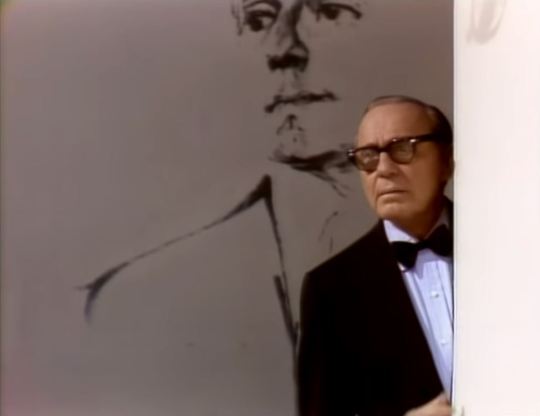
Jack Benny (Himself) was a Beverly Hills neighbor of Lucille Ball’s and the two were off-screen friends. Benny appeared on “The Lucy Show” as Harry Tuttle (a Jack Benny doppelganger) in “Lucy and the Plumber” (TLS S3;E2), later did a voice over cameo as himself in “Lucy With George Burns” (TLS S5;E1), and played himself in “Lucy Gets Jack Benny’s Account” (TLS S6;E6). He was seen in four episodes of “Here’s Lucy.” Benny and Ball appeared on many TV variety and award shows together. He died in 1974, a few weeks after taping “An All-Star Party for Lucille Ball.”
Mary Livingstone (Herself) married Jack Benny in 1927 and the pair remained together until his death in 1974. Initially an actor who appeared on Benny’s radio and television programs, she retired from show business in 1958, at the same time as Gracie Allen, wife of George Burns. Her voice (lip synched by Lucy) was used in “Lucy and Jack Benny's Biography” (HL S3;E11). She died in 1983.
This is Livingstone's first appearance on her husband's television show in fifteen years.
Don Wilson (Announcer. Himself) was a portly man with a deep resonating voice that made him very popular with sponsors in the early days of radio. He teamed with Jack Benny on radio and when Benny made the move to television, Wilson made the move as well, until 1965, when “The Jack Benny Program” ended.
Dennis Day (Himself) was an Irish singer who’s name and career were synonymous with Jack Benny’s, working with the comedian on radio and TV. It was Benny who gave him his big break in 1939 and Benny who kept him employed as a singer and naive comic sidekick. His “Gee, Mr. Benny!” became a well-known catchphrase. Day would play second banana to the comedian until Benny’s death in 1974. Day played an elderly bachelor hunting on a 1967 episode of “The Lucy Show” (S6;E7). Day died at age 72 of Lou Gehrig’s disease.
Day's real-life wife, Peggy Almquist, and his ten children Tommy, Pat, Margaret, Eileen, Danny, Therese, Cathy, Mary Kate and twins Michael and Paul. The childrens' surname was McNulty, Day's birth name. None of the family are credited.
Eddie Anderson (Rochester) was Jack Benny’s valet and sidekick first on radio and then on television. He co-starred with Lucille Ball on “Stars in the Eye” (1952) and one other Jack Benny special in 1969.
Mel Blanc (Sy / Airport Voice) is best known as the voice of Bugs Bunny and other Warner Brothers characters, but had acted with Lucille Ball on radio and in the 1950 film The Fuller Brush Girl. He did some voice dubbing (ADR) on “Lucy Goes To The Air Force Academy: Part 2” (HL S2;E2) in 1969.
Frank Nelson (Ticket Clerk) is the only actor to play two recurring roles on “I Love Lucy”: Freddie Fillmore and Ralph Ramsey. He also appeared as six other characters. He appeared in the first of the "The Lucy–Desi Comedy Hours” as well as a 1963 episode of “The Lucy Show.”
Benny Rubin (Information Desk Clerk) played the snarky Hollywood Bus Driver in “The Tour” (ILL S4;E30). His first “Lucy Show” appearance was in “Lucy and the Runaway Butterfly” (S1;E29) and he was also seen in “Lucy and Viv Open a Restaurant” (S4;E20) in 1964.
Guest Stars
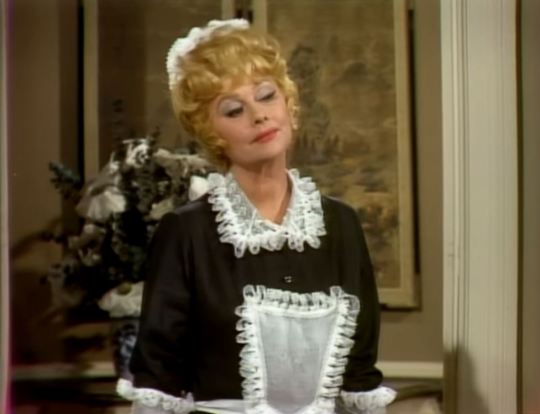
Lucille Ball (Janet, Benny's Maid) played all of the women in Jack Benny's life (including Mary Livingstone) on her own show in “Lucy and Jack Benny's Biography” (HL S3;E11) which aired just one week after this special. Benny paid tribute to Lucy on “An All-Star Party for Lucille Ball” (1974) just prior to his death.
Ball receives no screen credit but gets a verbal thank you from Benny at show's conclusion. Lucy has three lines and 30 seconds screen time!
Frank Sinatra (Himself) had appeared on “The Jack Benny Program” in 1951. Benny returned the favor by appearing on “The Frank Sinatra Show” that same year. Sinatra inadvertently appeared on “I Love Lucy” when a clip from his film Guys and Dolls was inserted into “Lucy and the Dummy” (ILL S5;E3) in 1955.
Sinatra is billed as 'Special Guest Star' in the opening credits.
Bob Hope (Himself) was born Lesley Townes Hope in England in 1903. During his extensive career in virtually all forms of media he received five honorary Academy Awards. In 1945 Desi Arnaz was the orchestra leader on Bob Hope’s radio show. Ball and Hope did four films together. He appeared as himself on the season 6 opener of “I Love Lucy.” He did a brief cameo in a 1964 episode of “The Lucy Show.” When Lucille Ball moved to NBC in 1980, Hope appeared on her welcome special. He died in 2003 at age 100.
Dinah Shore (Herself) was born Fannye Rose Shore in 1916. She was a singer, actress, and television personality, and the top-charting female vocalist of the 1940s. She rose to prominence as a recording artist during the Big Band era, but achieved even greater success a decade later, in television, mainly as hostess of a series of variety programs. She later changed her named to Dinah after her success with the song of the same name. She was famous for blowing a kiss to her audiences (“Mwah!”) at the end of each show. She appeared on “Here's Lucy” as herself in 1971. Her passions were golf, cooking, and painting. Shore died in 1994.
Dean Martin (Himself) was born Dino Paul Crocetti in Steubenville, Ohio, in 1917. He made his screen debut in a short playing a singer in Art Mooney’s band, but his first big screen role was 1949’s My Friend Irma with Jerry Lewis. This began a partnership that would be one of the most successful screen pairings in cinema history. Later, he also worked frequently members of “the Rat Pack”: Frank Sinatra, Joey Bishop, Peter Lawford, and Sammy Davis Jr. His persona was that of a playboy, usually seen with a glass of booze and a cigarette. Martin and Lucille Ball appeared on many TV variety and award shows together and made the TV movie “Lucy Gets Lucky” in 1975. He played himself (and his stunt man double) on “The Lucy Show” on Valentine's Day 1966. He died on Christmas Day in 1995 at age 78.
Martin receives no screen credit but gets a verbal thank you from Benny at show's conclusion
Red Skelton (Western Union Messenger) was born Richard Skelton in 1913. He left school after the third grade to join a traveling medicine show and from there entered vaudeville. His first film was Having Wonderful Time in 1938, which is where he first met Lucille Ball. The pair went on to appear together in Du Barry Was a Lady (1943), Thousands Cheer (1943), Ziegfeld Follies (1945), and The Fuller Brush Girl (1950). Skelton played himself on “Lucy Goes To Alaska” (LDCH 1959). He did two episodes of “The Jack Benny Program” in 1956 and 1958. He died in 1997 at the age of 84.
Skelton receives no screen credit but gets a verbal thank you from Benny at show's conclusion
George Burns (Voice of the Talking Telegram) was born Nathan Birnbaum in New York City in January 1896. He married Gracie Allen in 1926 and the two formed an act (Burns and Allen) that toured in vaudeville. They had their own hit show “The George Burns and Gracie Allen Show” first on radio then on CBS TV from 1950 to 1958, airing concurrently with “I Love Lucy.” He appeared as himself on “The Lucy Show” (S5;E1) in 1966 as well as doing a cameo on “Lucy and Jack Benny’s Biography” (HL S3;E11) in 1970. After Allen’s death in 1964, Burns reinvented himself as a solo act. In 1976 he won an Oscar for playing one of The Sunshine Boys. He was also known for playing the title role in Oh, God! (1978) and its 1984 sequel Oh, God! You Devil. Burns and Ball appeared on many TV variety and award shows together. He died at the age of 100.
Burns receives no screen credit but gets a verbal thank you from Benny at show's conclusion
David Westberg (Helicopter Pilot)
Verbal credit from Don Wilson at show's conclusion.
Trained Penguins (courtesy of Sea World San Diego) formerly worked for Jack Benny in “Jack Benny's Birthday Special” (February 17, 1969).
TRIVIA
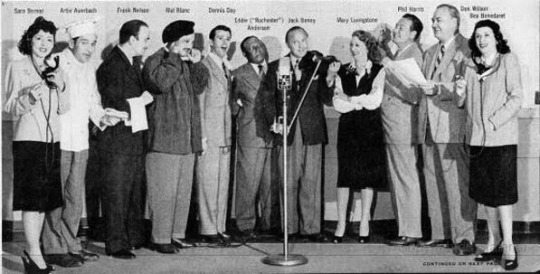
This is the last television show that reunited the entire cast of the Jack Benny radio show. Most of the cast made appearances on Jack Benny's television show as well.
Jack Benny had his own radio program since 1932. He brought the program to television (along with his radio regulars) on October 28, 1950. Jack remained thirty-nine-years-old, kept his money in his basement, and drove his old Maxwell car, just as he had done on radio. The television show ran until 1965. For the first five years, the show aired concurrently on radio and television. The TV program produced 931 episodes. It won an Emmy Award for best comedy show in 1961.

In October 1964, Lucille Ball was featured on a program where she played Mrs. Paul Revere. After the regular half hour show was canceled, Benny embarked on a series of bi-annual specials. Lucille Ball appeared on three of these specials.
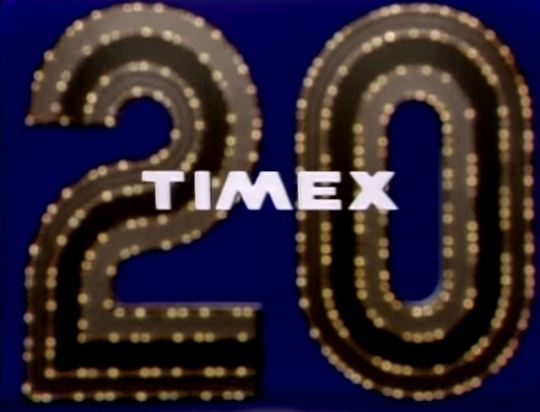
This show was sponsored by Timex.
As always, Jack Benny's theme song is “Love in Bloom.”
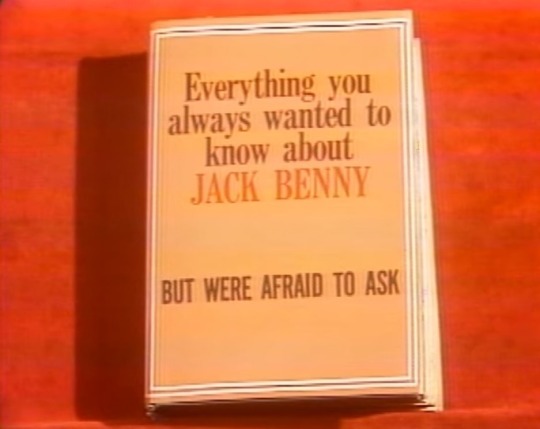
In the subsequent special “Everything You Always Wanted to Know About Jack Benny But Were Afraid to Ask” (March 10, 1971), Phil Harris thinks he's arrived in time for Benny's “20th Anniversary” show, but Benny tells him that it was four months ago.
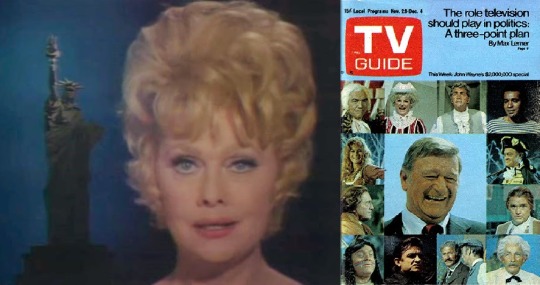
Lucy, Benny, Bob Hope, Dean Martin, George Burns, and Red Skelton, all appeared in the patriotic TV special “Swing Out, Sweet Land” which aired two weeks after this special on November 29, 1970.
THE SHOW
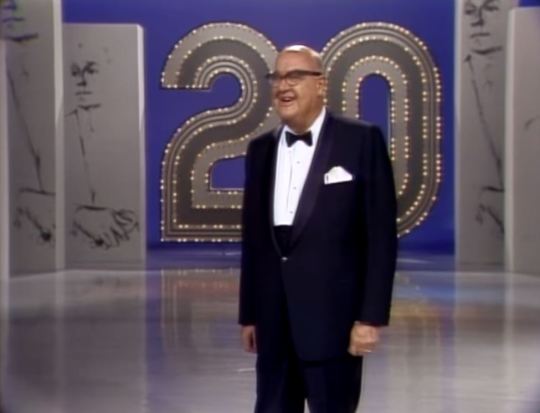
Announcer Don Wilson introduces Jack Benny, live on stage. He gets sidetracked saying how ungrateful Benny is. Jack watches from the wings and finally comes on stage to rebuke Wilson.
Benny: “You were just supposed to introduce me!” Wilson: “Introduce yourself!” (He walks off)
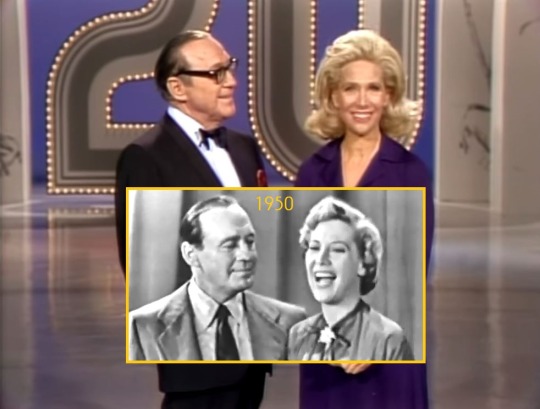
After a few opening remarks about his years on television and radio, Benny introduces Dinah Shore, who was also a guest on his very first TV show in 1950. They reminisce about that show. Dinah sings “All of a Sudden My Heart Sings” by Harold J. Rome, Henri Laurent Herpin, and Jean-Marie Blanvillain.

Dean Martin knocks on Jack's dressing room door to wish him a happy anniversary and dance “The Anniversary Waltz” with him. They sing and dance out the door. The bit lasts less than 30 seconds.
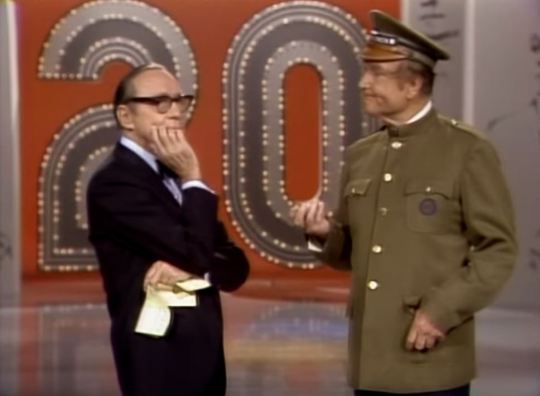
After a commercial message from Timex, Red Skelton skips on dressed as a Western Union messenger to give Jack Benny a telegram. He makes Benny laugh when he says “I'm a dreamer, aren't I?” while holding his hand out for a tip. He is on screen / stage for less than a minute.
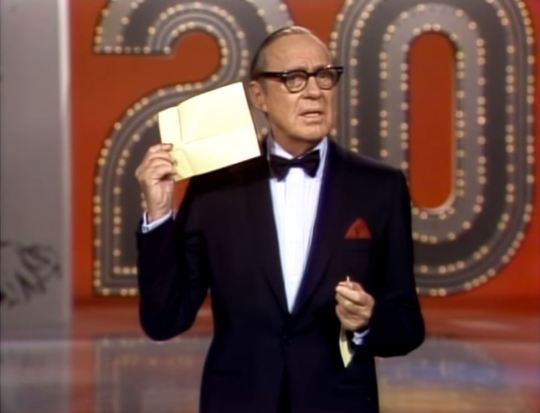
Skelton has delivered a talking telegram from George Burns, which instructs Jack to hold it up to his ear to hear the message.
Voice of George Burns: “Only an idiot would stand before 40 million people holding a telegram up to his ear.”
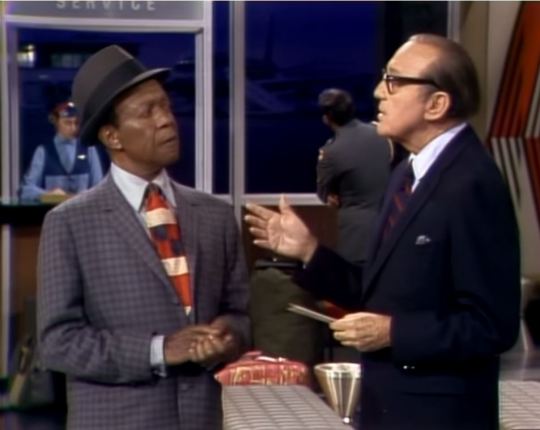
Benny has recruited Rochester to drive him to the airport for his trip to Mexico City.
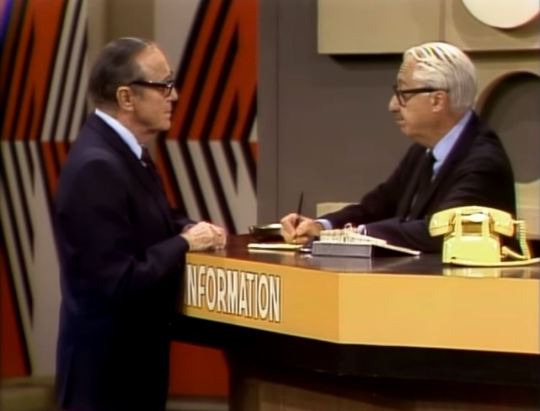
Wondering about the departure time, he asks at the information booth, manned by Benny Rubin. Whatever Benny asks him, his answer is “I dunno.”
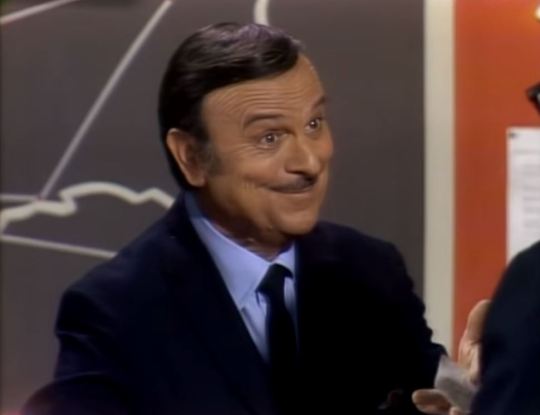
The ticket clerk is played by Frank Nelson, who greets him with his trademark “Yeeeeeeeeees?”
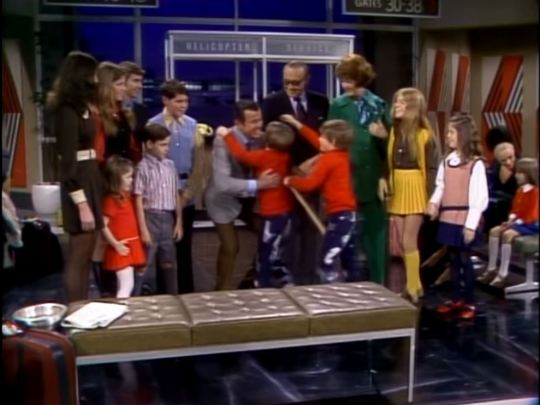
At the airport, Benny runs into Dennis Day, his wife Peggy, and their ten (!) children.

Rochester gives Benny's overweight luggage to a Mexican man (Mel Blanc) on the same flight.
In response to everything Benny asks, he says “si”. The man's name is “Sy”. He has a sister named “Sue.”
Blooper Alert! Despite this familiar old “si / Sy / Sue” routine, Benny mistakenly calls Rubin “Sue” then corrects himself saying “si” before Rubin chimes in “Sy”.
Benny hears hears a flight announcement that says his trip is delayed. Another voice comes on the public address system to say:
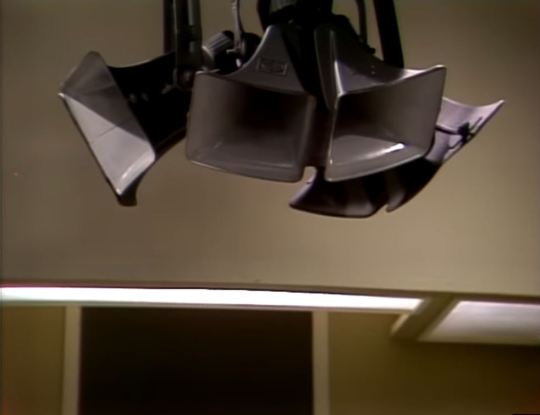
Voice (Mel Blanc): “Attention please. Attention! Plane leaving at gate five for Anaheim, Azusa, and Cucamonga!”
This is one of Mel Blanc's earliest routines from the Jack Benny radio show. Instead of a train station, here it is an airport.
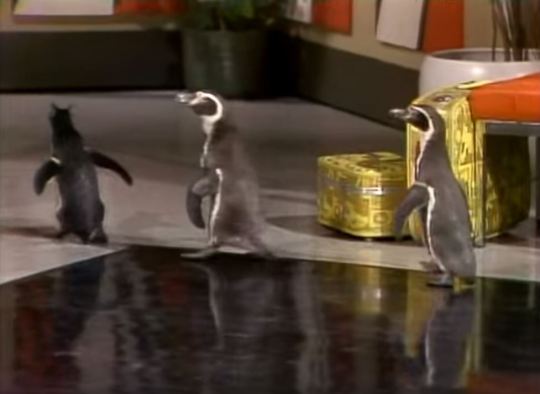
Blanc's voice announces a flight for Alaska and three penguins come toddling toward the gate. These three penguins were also featured in “Jack Benny's Birthday Special” (February 17, 1969), which also starred Lucille Ball, Benny Rubin, Don Wilson, and Dennis Day.
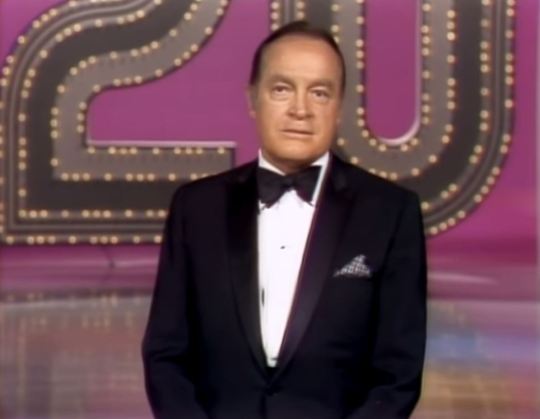
Bob Hope does a monologue about Jack Benny. Benny joins him onstage and Hope sings “Thanks for the Memory” (his theme song) with special lyrics about Benny's age. In response, Benny sings a few bars of “Love in Bloom” (his theme song) with special lyrics about Hope.
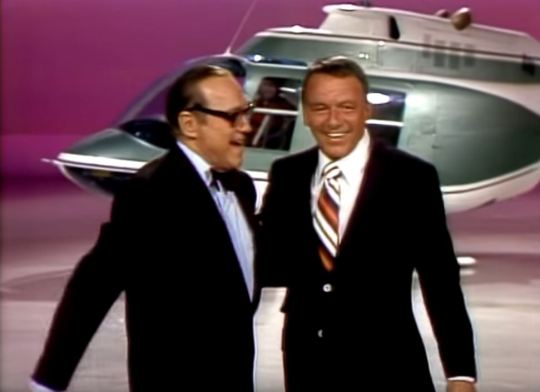
A helicopter lands in the studio and Frank Sinatra steps out of it! Frank invites Benny to go to the movies after the show. The double feature is The Kissing Bandit (1948) and The Horn Blows at Midnight. The Kissing Bandit is a film starring Sinatra that he loathed. The Horn Blows at Midnight is widely considered Benny's worst film. Sinatra sings “I Get A Kick Out of You” by Cole Porter. Sinatra substitutes the alternate lyric “Some like the perfume from Spain” instead of “Some get a kick from cocaine.” However, instead of following with “I'm sure that if I took even one sniff” he sings “I'm sure that if I took one look.”
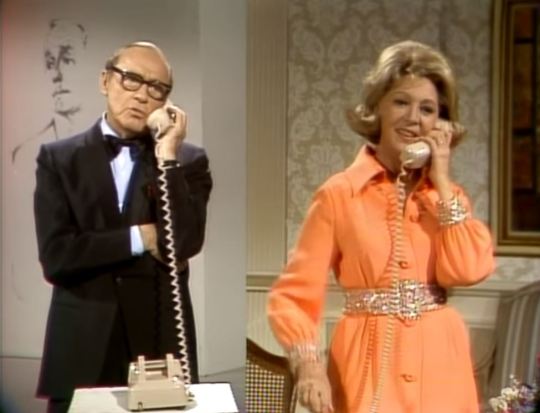
After a commercial, the scene is set in Jack Benny's home, where Mary Livingston picks up the telephone. It is Jack calling from the studio. He asks her to join him after the show for supper.
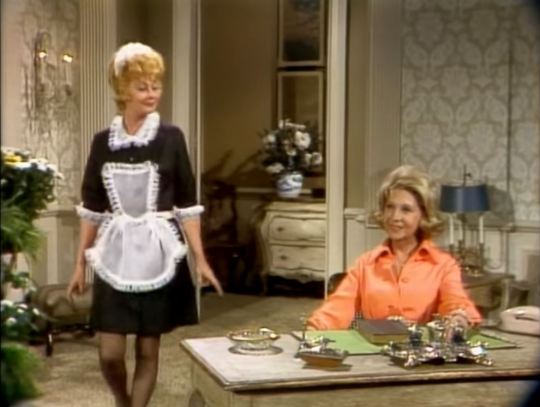
Mary calls her maid, Janet (Lucille Ball). Ball gets a huge round of applause from the studio audience.
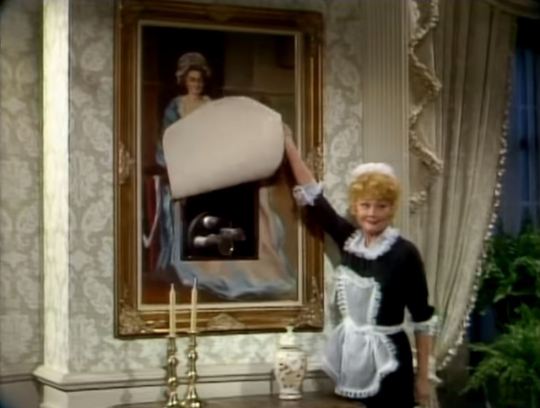
Janet reveals that Mary's been on TV the whole time because Jack has hidden a camera behind a painting of Betsy Ross!
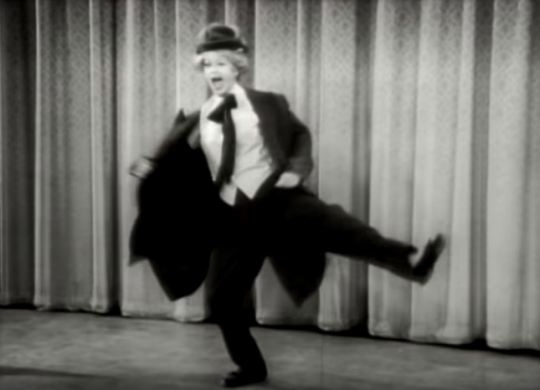
Back in the studio, Benny introduces film clips from his past 20 years. Stars include Jimmy Stewart, John Wayne, Marilyn Monroe, Ed Sullivan, Humphrey Bogart, Fred MacMurray, Kirk Douglas, Liberace, Tennessee Ernie Ford, Nat King Cole, Ginger Rogers, Charles Boyer, George Burns, Gracie Allen, Bob Hope, Bing Crosby, Milton Berle, Danny Thomas, Frank Sinatra, Lucille Ball, David Niven, Carol Burnett, Raymond Burr, Johnny Carson, Andy Williams, Rock Hudson, Dan Rowan, Dick Martin, Tom Smothers, Dick Smothers, Cary Grant, Billy Graham, Lawrence Welk, Dan Blocker, Robert Goulet, and Phyllis Diller.
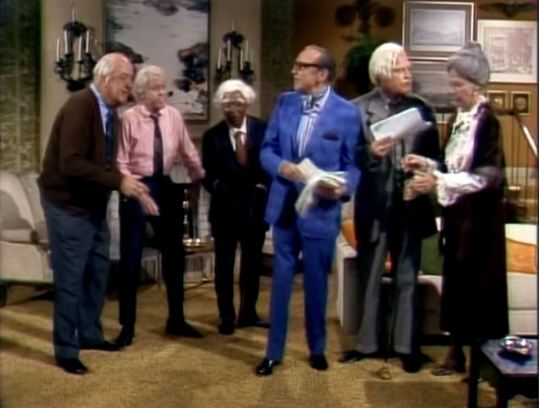
Jack Benny thinks ahead to what the next twenty years will bring. Flash forward to Rochester with white hair and a cane answering the door to a bald Don Wilson and a stooped over Dennis Day. A creaky Bob 'Road-To-Medicare' Hope joins them, supporting himself with a walking stick. A gray-haired Dinah Shore comes through the door and blows everyone one of her famous kisses “Mwaah!” The kiss sends her reeling across the room. Jack skips down the stairs energetically, not having age one iota since 1970 and distributes scripts to his ancient co-stars. Even though Jack Benny died in 1974, only four years after this special, he will forever be only 39 on TV.
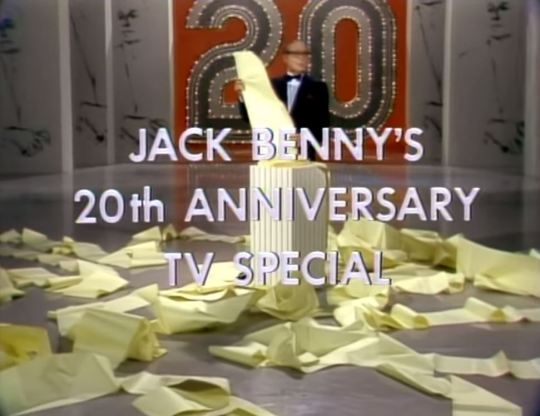
After the last commercial break, Jack takes a moment to thank his co-stars, and all of his viewers throughout the world. The camera pulls back to reveal an unfurled stack of computer printout and Benny starts reading the names of his viewers – alphabetically! “Mr. and Mrs. Tony Ames, Miss Terry Arco, Mr. and Mrs. Albert Aaron, Mrs. Andrew Aaronson...”
This Date in Lucy History – November 16th
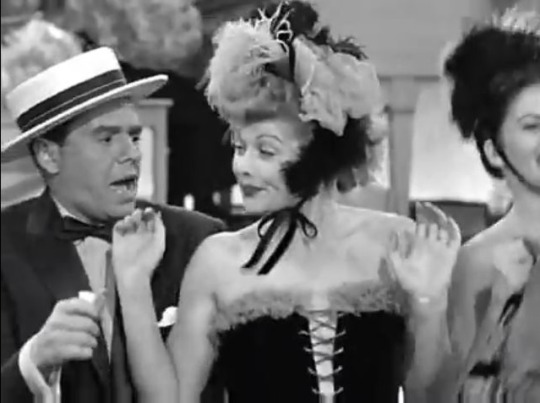
"The French Revue" (ILL S3;E7) – November 16, 1953
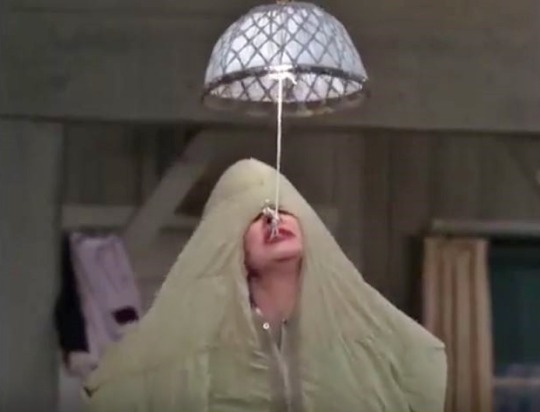
"Lucy Becomes a Father" (TLS S3;E9) – November 16, 1964
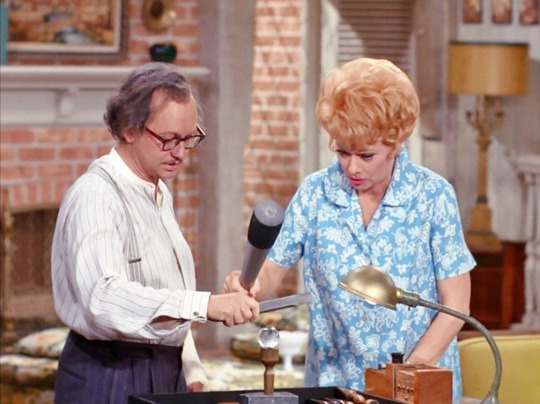
"Lucy the Diamond Cutter" (HL S3;E10) – November 16, 1970
#Jack Benny#Jack Benny's 20th Anniversary Show#Lucille Ball#Bob Hope#Dinah Shore#Hilliard Marks#Benny Rubin#Mel Blanc#Eddie Rochester Anderson#Mary Livingstone#George Burns#Don Wilson#Dennis Day#Frank Nelson#penguins#Peggy Almquist#Frank Sinatra#Dean Martin#Red Skelton#David Westberg#Timex#Love in Bloom#I Get A Kick Out of You#Helicopter#All Of A Sudden My Heart Sings#Thanks for the Memory#The Jack Benny Program#TV#1970#NBC
5 notes
·
View notes
Text
Turning 47: pt. XV
“Ch-ch-ch-changes”
26 May 2018
“You know, in Sweden they make these perfectly shaped butter knives. They’re just ideal for spreading butter on pancakes,” I say as I wolf down a hot stack. It’s a bright Sunday morning in Evergreen, Colorado at Benny & Kathleen’s. Thankfully, they were home last night and were willing to put me up for the night (kicking their middle child out of his room for me...extra thanks to him). I woke to a family of deer peering in my window from the surrounding forest and the smell of breakfast coming from the kitchen upstairs. How did I deserve all of this? Again, I am overcome by the generosity and warm hospitality of people who I haven’t seen in forever.
“So, how did the meeting at Barnes & Noble go?,” they ask with baited breath. “Well, wow...,” I reply, and proceed to reiterate the details of the story that I have laid down in the previous parts of this tale, showing them the photo of Arla and me in the park. “Oh wow! It’s really undeniable,” they marvel. I am here and present, but also in a bit of a daze. That just happened, and here I am in the home of old college friends on a Sunday morning, eating breakfast before they go off to church. Time is playing ALL KINDS of tricks. Now is then is now is then. Waxing and waning. Kathleen is buzzing around the kitchen, whipping up pancakes in her Sunday best, while Benny and I commisurate over coffee. It’s as if I walked through a wormhole from 1993 to 2018. I feel the same way in their presence as I did when I was 22.
“So, are you going to the reunion?,” Kathleen asks, effervescently as she does. ”I think I have to, seeing as I was professoring there this last term. If I can cobble the funds together; definitely,” I say, and we commence to listing all of our old classmates who we should pester to be there. “Do you think Dan Rauter would come?,” zips Kathleen. ”I’m not sure. I’d love to see him. Just the whole gang. That was one of the best things about being back at Wheaton, being able to see so many people who I hadn’t in so long. It was crazy. Yes, I really need to be there,” I say. Declarations are made, and names dropped. It’s so good. So bizarre. It was crazy to see so many people over the Spring term, slipping in from a faded memory to LIVE, flesh and blood reality, just like sitting here at Kathleen & Benny’s dinner table.
The house is bustling with activity as Kathleen and the kids are bolting out the door to make it to the Episcopal church. Benny and I are engrossed in a light theological conversation, and he asks Kathy to save him a seat as he will catch up soon. Benny has already been to one early morning service this morning, a Catholic mass, and he is explaining to me his slow conversion to Catholicism.
Unbeknownst to me, Benny had grown up in the Evangelical Free Church (a merger of the Norwegian and Swedish Free Churches in America from 1950), just as I had. It turns out we were both at the same Youth National Conference in Denver in 1988. “Did you know Big John?,” he asks. “Wow....there’s someone who I haven’t thought of in decades. Yeah, I even drew a cartoon picture of him,” I confirmed. Neither of us knew much of who Big John was or where he came from, but he was definitely memorable; a man in his 50’s or 60’s, who must have been on the spectrum. Who or which group was he connected with? If it raised any eyebrows at the time, I didn’t hear of it, nor did I hear anything ever happening. Today, I don’t think his presence would be acceptable, just cause, well, you know. But again, it didn’t cross my mind then and there was nothing untoward that happened to my knowledge.
Going to the National Conference was the hilt of summers for me back in high school; 2500 teenagers converging in one place for a week. Half of those were girls, and my hormones were racing around like atoms in the particle accelarator at FermiLab. It was a perfect stage on which to try out all my extroverted show off tricks; breakdancing, skateboarding, or just being able to make people laugh. It was heaven, and the fact that all of these kids were coming from a similar place in the church community meant that I didn’t have to feel awkward or edgy about being a pastor’s kid. And I remember, there was this one person at this very National Conference in Denver who left a massive and lasting impact on me, one which solidified the course I’ve been on to this day. His name was Fred.
Fred was a part of the youth group that came down from Rochester, Minnesota, and, in my opinion, that group was THE coolest bunch of kids I’d ever met in person. They were punk and New Wave, and while I had dabbled in the style a bit, this was the first time I had ever been around people actually like that. I mean, I had seen that style in John Hughes films and on MTV, but never in real life. Where we came from on the Eastside of Des Moines, it was all Classic Rock (when it was just known as Rock); feathered hair, Van Halen, combs in back pockets, and muscle cars. These kids from Rochester were all laid back skaters. There were so many firsts I witnessed coming from that group. I just wanted to hang with them. And in right there in the middle of all of them was this guy Fred.
The thing about Fred that blew me away was that he was plain, and at least physically, NOT cool, but every one of the other cooler-than-Alaska kids deferred to him with respect. Fred was fairly overweight, which where I came from was an instant social death sentence, but if it was something that he ever felt insecure about, it didn’t show. No, he was solid, sitting in their midst like a Buddha, normal as could be; the sun in a solar system set-up. And I thought....if this guy, who by all appearances should be a cast aside (in my limited, teenaged prejudiced opinion), is able to just be, cool with himself as he is and command the respect he does...then...why should I ever give a second thought to what other people think about me? And that set a tone for me, going forward. My early leanings toward non-conformity were absolutely crystalized meeting Fred. I think I may have written him once after that conference, but there was never a correspondence kept up. I don’t even remember his last name, but I do remember the impact he had on me. Thank you, Fred.
So, Benny comes out of the same soil that I did, which is just wild to me. Wilder still, is that his train has switched tracks toward Catholicism. As he explains it to me, it all comes down to doctrine. The Catholic church is less emphasis on one’s individual personal responsibility in attaining and keeping up one’s salvation. It’s already a done deal. Its all in the doctrine and the sacraments , allowing him to just go and worship, without having to strain and stretch to try to receive God’s favor. It’s already been done, he just needs to be present. Kinda like Fred, just being there, content in this space. He makes an appealing argument, and I am very far from being dogmatic about the different flavors of Christendom. “Do you think it’s the Protestant appointment to continually fracture into smaller and smaller shards of belief until it stops meaning anything?;” I ask. How many denominations can there be, each one believing their way and vision is the RIGHT way? Benny says this is part of why he started investigating Catholicism.
I remember back when I was in undergrad at Wheaton, one of the best parts was trying out these different flavors of Christian worship. There was the hippie church, Jesus People (JPUSA), in Chicago. Then there was the generic, big box non-denominational variety, like Wheaton Bible or College Church. And the Presbyterian churches. And the Episcopal churches, like Church of the Resurrection and St. Mark’s (where I had my first communion with REAL wine, not Welch’s Grape Juice). It was a blizzard of experimentation, investigation, and research into the style, views, and formats. Now, at Wheaton, being a college firmly rooted in evangelicalism, going to church was basically expected, which meant that Sunday lunch in the cafeteria was a natural place for assessments on whether or not others had gone to church, based on the clothing people wore. I am more than certain that several stressed out about this to the point where they would dress up for lunch if they hadn’t made it to church. I couldn’t be bothered with that. If there were ever a snide comment like, “Where’d you go to church, Kurt?”, I’d just say I had spent some time in The Word. Not only did it cut the snark, it was 100% true. I called my bed “The Word”, with a big sign on it stating its name. This became a problem for at least one of the underclassmen on my floor when I was an RA, borderline heretical. I do remember, Brendan. 😉
It is easy for me to listen to Benny describe his journey and thinking. We come out of the same place, and I can understand transformation and maturation far more than I can stagnation and samey-sameness. I live in Sweden now, have been for 16 years. True belief in Jesus, or any deity, is highly out of place and foreign; viewed with eye-narrowing suspicion. While Christianity is solidly a part of Sweden’s history and heritage, it has also always been lock and step with the government. For hundreds of years, it was mandatory for the people of Sweden to attend church. The church was in charge of keeping people in line, as well as for the country’s census and population control. It was not optional. Therefore, church in Sweden is not viewed as a place to receive any kind of true belief, but an institutional organism where tradition is upheld; in infant baptism, weddings, and funerals. This underlines my conviction that church and state should always remain separate. Belief should always be a choice, not compusory.
So, I don’t blame Swedes for being narrow-eyed, at all (I half-expect my Swedish friends to be reading this side-eyed, all this church talk, but I’m cool with that. This is my story, this is my song). Moving here was a cultural womp on a multitude of levels, including spiritually. I share this with the Hindus, Jains, Buddhists, Muslims, Jews and anyone else I’ve encountered who has moved here with a spiritual belief system from outside. It is a spiritual desert, with a fixation on the sensory and material here-and-now. Belief is dead wood, relegated to tradition or the sole domain of the sciences. But it is good to know, life still does thrive in the desert (if you’ve ever watched David Attenborough), it just looks and behaves differently than, say, a jungle or forest. I have adapted and I feel good about where I am, and I feel good about the people around me. I reject “us vs. them”. It’s just us. If I am viewed as a “them”, whether it’s true or not, so be it.
Benny and I wrap up. I go downstairs to pack, and do a couple “idiot checks” to make sure I am not leaving anything behind. And then we’re out the door, headed to our cars. “Benny! It’s so great to see you. Send me your address. I will send you some Swedish butter knives. You’ll see,” I bark in parting. And we head out, up the drive and onto the winding roads of Evergreen; Benny to join his family at the Episcopal church, and I, through the soaring cathedral of the Rockies and up to Boulder to see if I can meet up with Jolly Northrup.
I text Jolly... “Jolly!”
1 note
·
View note
Text
New Look Sabres: GM 38 - OTT - Merry Meh

3-1 Regulation Loss
This team is Jack Eichel and the Merry Meh Men. Remember when you were a kid and you got a shirt from your grandma for Christmas? It was a gift and whether you liked it or not you had to be thankful for it but… you know as a kid that’s… well meh. I wanted the Hess truck, Grandma, not another button up I’ll only wear to Church! This game was that. That meh feeling you get on Christmas morning when you peel open the shirt box. The Ottawa Senators have decided to be the watchable kind of awful and are giving even the good teams a run for their money every now and again. Jean-Gabriel Pageau is the French wonder man and hometown kid that would have been a perfect player for the organization when they launched 25 years ago. He’s one of only a few stars left on their roster. Anthony Duclair is having a bit of a revenge tour scoring goals with the urgency of last-minute Christmas shopping. Duclair and Pageau are having themselves nice little seasons while the Canadian Capital positions itself for another high draft pick. Meanwhile the Buffalo Sabres are supposed to be past the stage of angling for high draft picks but they don’t seem too eager to reclaim a playoff spot at the moment. You could have had a nice little string of wins going into the Christmas break and sailed into Boston looking like a force. Nope, we get to have a loss to the Ottawa Senators on the rolodex of memories for this season. Great! Look, I don’t think this was even the worst Sabres game this month but geez, you got to win games like this if you sincerely want to make the playoffs! Jack Eichel’s point streak, personal or not however you want it, is over where it started against the Sens. It was almost to twenty games! It was almost a fourth of the whole season long! UGH! This game is hardly worth writing about. It was just so very meh.
The Sabres started out pretty well. I mean both teams only had one official shot on goal for the first ten minutes. But they weren’t losing yet. It was boring more than anything else. I started thinking about how terrible that arena outside Ottawa is. If you think we have a bad owner, oh baby, you ain’t seen nothing. They could’ve had a sweet new downtown arena and Eugene Melnyk bitched and moaned his way out of it. To the two Sens fans reading this I apologize, this game doesn’t provide me with a lot of original material. As the shooting picked up the saves picked up too. Craig Andersen and Linus Ullmark seemed pretty equally matched. Even before the Sens broke the ice the game was getting more physical. Boring teams do that sometimes to get something going. Mr. Tough Boy on the Sens is Brady Tkachuk, he’s got the face of a bully and everything, but the problem is he’s also pretty decent at hockey. He’s fighting along the boards in the last minute of the first period and quickly gets the puck out to Jean-Gabriel Pageau who beats Ullmark on a one-timer. Sting though it did there were hardly any chances in that period, and you expect the Sabres to turn it on at some point, right? Well… sorta. Jack Eichel and the usual suspects had their chances in the first period but in the second period as the Sabres asserted their will a bit more it was scrubs like Jimmy Vesey and Zemgus Girgensons getting the hottest chances. But this period as well reeked of meh. Even as the Sabres took over every 5 on 5 statistical category though only meaningful play was late in the middle period when Evan Rodrigues reclaimed a puck off a Sens defender, ERod yeah, do you remember him? He got the puck out to the slot where Zemgus Girgensons hardly touched it really to put it on net and saw it bounce off some limbs and posts to go in. The game was tied after a period that just felt inscrutably meh.
When the players you don’t care are still on your team are the ones injecting life into your game you know its not your night. It’s Christmas Eve, I’m not going to go on and on about an ultimately meh game. Long story short: Jean-Gabriel Pageau scored a sneaky one to reclaim the lead about four minutes into the final frame as the home team decided it wanted this one more. About fifteen boring minutes later the Sabres pulled their goalie and couldn’t shut down a rush the other way and Brady Tkachuk put in the insurance goal. This one ended 3-1 in regulation. Now I’m not going tell you many games are on the Coach. I think we’ve seen enough of those come and go here that we understand it’s the players sometimes too. We have a lot to say about certain players on this team in this game, but I have to throw a question Ralph Krueger’s way: Where was the motivation in this game? A divisional matchup in December on the day before Christmas Eve. Did you go around the locker room before the game and have every player talk about what they’re doing for the holiday? COME ON! These are the missed opportunities that are going to cost us in February, March and April. You know that. How do you get these players motivated to play a game like this? You know how but you clearly didn’t last night! On the player side of things I’ll say I don’t care how improved Rasmus Ristolainen is, I want him traded already! While you’re at it you could delight every Sabres fan with a move ridding us of Jake McCabe and any number of the other players on this team who have been here too damn long and done precisely nothing! Lawrence Pilut is wasting away in Rochester while Colin Miller gets benched for the ghost of Zach Bogosian!? You have your solutions on defense within the organization! Move broken parts out!
Christmas Eve isn’t a good time for rants. That was for yesterday for Festivus. Let’s move past this game. Midseason Thoughts is something I like to do around Game 41 every year. That game normally falls right around New Year and this year that game is Tampa on New Year’s Eve. Look for Midseason Thoughts after that in the first couple days of the New Year. It’s fun to write a blog about this team that’s not about a specific game because most of the games make you feel a very specific way. Looking at the team holistically… well it makes you feel a certain way too but… yeah just read it. Like, comment and follow to keep track of this blog. I’m debating a midseason rebrand too but unless it seems really necessary I’ll probably wait until after the season. I really hope this season doesn’t end in early April again. Too bad they’re giving me reasons to believe it will again. Nonetheless, Merry Christmas Happy Holidays and Let’s Go Buffalo!
Thanks for Reading.
P.S. The Hurricanes v Leafs game yesterday was everything I hoped the Sabres would be by now – fun and high scoring. Imagine that!
0 notes
Text
Wes Peden, juggler: Zebra, London International Mime Festival
Recognised as one of the most innovative jugglers ever, American Wes Peden – who comes from Rochester, New York – has been voted the world’s most popular juggler nine times. His father, Jeff Peden, taught him to juggle when he was five, and they started performing together when Wes was eleven. At 14, he won the gold medal in the International Juggling Association Juniors Championship. He went on to study at the Dance and Circus University in Stockholm from 2007-2010. Wes holds countless juggling world records, won a bronze medal at the 33rd Cirque de Demain festival in Paris, and has appeared internationally from Tokyo to Broadway, including before the King and Queen of Sweden, and at Perlan glacier museum in Iceland.

Based in Stockholm, Wes tours his solo shows and gives masterclasses. UK audiences may have seen him in Water on Mars by Plastic Boom – the company he formed with Tony Pezzo and Patrik Elmnert – and his sizzling guest spot in Gandini Juggling and Alexander Whitley’s Spring. He now returns to the UK, bringing his solo show, Zebra, to the 44th London International Mime Festival. It runs at the Southbank Centre’s Purcell Room from 24-26 January 2020. Wes chats to Liz Arratoon from Helsinki, while rehearsing for an opera.
The Widow Stanton: What is the opera you’re working on? Wes Peden: It’s a circus opera, CircOpera. They’ve written a story that uses some classic opera songs and lots of different circus disciplines to try to have, like, a fun way to introduce kids and families and people that might not necessarily go to see a traditional opera to the art form.
Do you find that your juggling work is combining more with other art forms now? Well, I definitely get inspired by other art forms and it’s very often when I’m in group shows it’s not just other jugglers, you know. Gandini has worked with many other types of dance, and I’ve been in shows that have theatre in them or other circus disciplines, and I definitely get inspired by the type of music in the show. For example, opera music, I’m performing to a soloist playing Flight of the Bumblebee on a tuba. That kind of inspires a different sort of juggling than I would ever do on my own. So, definitely.
Let’s go back to the beginning; is or was your dad a professional juggler? Yeah, he still does perform quite a bit. Before we were juggling together he was already doing about 100 shows a year. When I started getting more and more into juggling we created a duet show, and were performing that for a few years, with many shows around the east coast of the States.

Did it come naturally to you as a kid or was it just a lot of hard work? Kind of both. I felt like I had a natural talent for it in one way and it made it not feel like work. When you’re young and you learn some things, it doesn’t seem so surprising that you can’t… you don’t get embarrassed that you can’t do anything at all. You can’t juggle, but you can’t ride a bike either. It’s all normal. There are many things you can’t do at that age. Also I was dyslexic and asthmatic, so school was very difficult because of my dyslexia and sport was hard because of my asthma, but then juggling, I was like, ‘Oh, here I am at least on an equal playing field as everybody else’. Having limitations in those other areas kind of pushed me to follow my skill in the juggling world.

How would you describe your juggling style? The main thing that defines me is that the reason I juggle is to create new tricks, new forms of juggling and to try to make something that someone has never seen before within the juggling world. I want people to come out of my show thinking: “I’ve never seen anything like that. I didn’t know juggling could be like that. Those were some tricks I didn’t imagine would ever be possible.” Because I was lucky enough to juggle for many, many years – 24 years I’ve been practising – I had a lot of time to build a lot of technique. I had a lot of skill with many different props so I try to make these new ideas as technically advanced as I can, to use my full energy and my full skill to make as high-quality new ideas as possible. But what defines my style is creative and new shapes but still a really high skill level.
Were you inspired by any of the great jugglers from the past? Absolutely. I watch juggling constantly to get inspired by things that have happened already and by what elements I can see, like, ‘Oh, what made that trick so special? What’s important about this juggler’. There are a few jugglers of more recent years, because juggling is still quite young, so lots of the important jugglers are really not that old, they’re still alive. There’s Kris Kremo, who does incredible stuff with balls and hats that really inspires me, and another is Sean McKinney.
I saw him when I was nine years old at this competition where everyone was performing with, like, jazz music, in a vest [waistcoat], kind of in this Kris Kremo-type old-school way but at this time everything was a little stricter for no real reason, and then this guy comes skateboarding on to the stage in jeans and a T-shirt and does incredible new beautiful kind of punk juggling. I was like, ‘What is this guy?’ and he inspired me that juggling didn’t have to be done in just one way. It didn’t have to have a certain aesthetic, that it was broader than I’d ever imagined. So when I saw him at that young age I was like, ‘OK, juggling isn’t this, juggling is whatever you want it to be’.
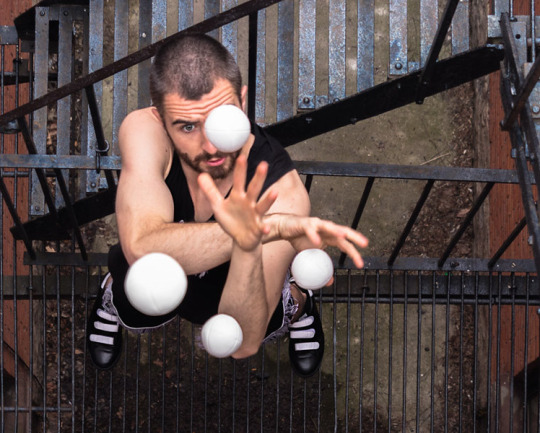
When you’re creating intricate patterns and sequences how do you plan them? There are certain aspects of juggling that you can do best on paper, for me anyway, and certain aspects that you have to be literally trying it to see what works, where the momentum is and how fast you can move or what makes sense with the flow of where the catches are. So it’s a combination of both. It will often be that I’m working on a trick and then I realise something about it, ‘Oh, the momentum of this part makes me want to throw the ball round there’. I film it on my phone and next time I’m on a plane or a train I look at the videos and ‘OK, now I realise that new aspect of the trick’. I will write down many ideas of how to twist that or expand a new idea. Then next time I’m in training I’ll look at my notebook and try all those new things, film them, so it kind of bounces back and forth between literally work in the studio to see how you body and objects work best together and then more, like, academic work back in the office or while I’m travelling.
You have so many records; it’s not about numbers but how many of each prop do you juggle? [Laughs] I have some, but to tell you the truth, it gets a little bit tiring, like, trying to add just one more ball or one more club. I might have invented the most five-club tricks that have ever existed but I don’t juggle the greatest number of clubs that has ever been done. I perform seven clubs and seven balls but I try to… yeah… OK, to be able to juggle seven, eight, nine balls you need speed and accuracy and dedication, and how many hours would I need to put in to add one more ball? That would give one image and it would be amazing, but if I took all of those hours and that dedication and then added my creativity to it and instead used that time to try to make something that no one has ever gone for before.
Up until I was, like, 16 or 17, I was going after just the hardest trick, the biggest trick, the most clubs and after I went to circus university and had more classes in dance and composition I started banging my time and my skill more into composing things that are a little bit harder to put your finger on, because when someone says: “How many of this can you juggle,” it’s easier to compute than, ‘Well, I’ve developed this new technique where rings spiral around my arms in hundreds of different ways. By the time you see the end of the piece you’ll have a whole new vision of how things work. It’s a bit harder to envision, but you have to come to see the show’. [Laughs]
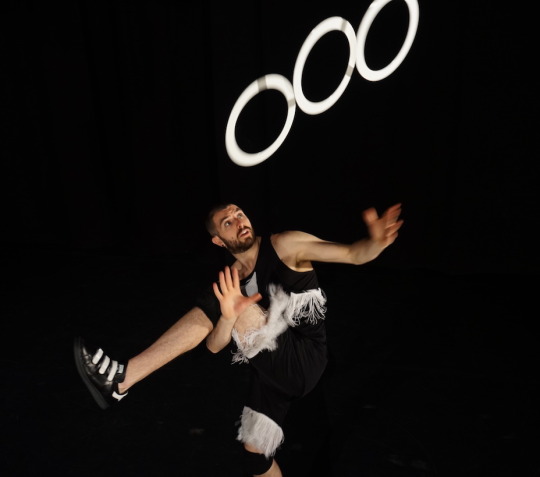
Do you prefer one prop to another? It depends. When I was young I absolutely preferred clubs, like, clubs are the way to be, they can flip this way, the other, rotate, roll… there are many options with them. Then when I started to learn a bit more about how to move my body, I got more interested with balls because you can use them to go around your body, they’re easier going down to the floor and back up. And now I can kind see every prop for what they are good at and if I have an idea of one way of using juggling, like, ‘Oh, this new cross-armed behind-the-neck idea’, what prop will work in that idea best? So now my juggling is more about concepts and then I pull whichever object works with that concept the best. I see them all now like different colours for a painter, whatever is most suitable for this next painting.
What is the best tip you could give to a kid just starting to juggle? I would say to remember that you don’t need three balls to juggle, you can start with one, or any object and try to invent a trick that is fun; something that you think is cool to do. Maybe take your shoe and throw it up and clap behind your back and you catch it again. Or maybe you can set up some spoons on the table and flip one with the other… not to think that juggling is just getting three balls in the air. Juggling is just a relationship between you and objects and making fun tricks that express yourself. I’d say, make sure you’re having fun and, you know, keep going. You will teach yourself as you invent things and gradually build skill. But always make sure you’re having fun.
You mentioned circus university, why did you choose DOCH? I was watching lots of juggling videos and different jugglers from around the world and trying to figure out where they all came from and who taught them and where their different styles were developed, and I realised a lot of my favourite jugglers were from Sweden, or Denmark, or Finland. And then I found out that a bunch of them were going to this school, DOCH. The head teacher at the time was Jay Gilligan, who is a very great juggler; a very clever guy in the modern world of juggling. That was it, ‘I already know his work, I want to juggle like the other guys, so let’s go there and study’.
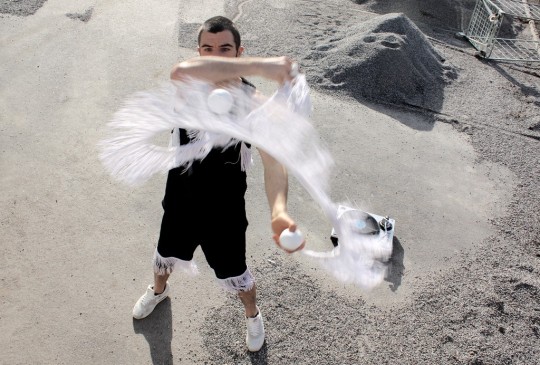
What did it add to your already considerable skills? When I got to the school Jay explained to me: “OK, we have three years to juggle. We're going to be spending the first year developing your technique and making sure you understand everything you can about literal juggling; the tossing, the throwing, making sure everything is clean. The second year we're gonna teach you how to compose, which will not necessarily have anything to do with throwing and catching.” There were certain things when I was supposed to make an interesting routine while holding a watering can, which I wasn't allowed to throw or catch. You have to forget about your skill as a juggler and just use your creativity to make something good without skill. So for a year I did many different composition exercises, like, 'OK, make 100 tricks in 15 minutes'. You’re like, ‘Uhh!’. It really works your brain in the same way that juggling in previous years had worked my muscles and my muscle memory.
And then in the third year you use your skills developed in the first two, you combine your juggling skill, your composition, you figure out what you want to express and put those skills to work in something from yourself. I think that is the main difference between juggling just on your own and going to a school and having someone make you do composition exercises that really got out the creative side of me and let me develop something that was unique to me.

What happened to Plastic Boom? The trio performed quite a bit together and then had a contract working in Vegas on a show. The others have stayed there but I got a replacement for my part so I could continue to do my own full shows and live a more artistic career, so we've kind of split ways a little bit.
Are you affiliated with Gandini Juggling? When they first started to make Spring, me and the two other jugglers from Plastic Boom, all three of us were going to be in the show, but then when we got the offer for the show in Vegas, it kind of was hard to organise with the creation time period of Spring so we jumped out of the project. But then when I wanted to leave Vegas I was partially in the Spring show. I’m good friends with Sean [Gandini], we really share similar visions of why we like juggling, where it can go. We both have energy to develop the art form constantly and now they are my producers.
Did winning a medal in Paris help you? Yes, it did. In a way, my life is kind of a balance of performing in other group shows, like what I’m in now in Helsinki, and doing my own solo work. And after doing Cirque de Demain I got offers doing some varieté theatre in Germany, where I worked two months a year for a few years. Always while I was just doing an act in another show it gave me an opportunity to be in the same place for a couple of months and really work on the stuff that would be in my next show. In happenstance, after Paris, I got booked for one show in Germany, and I had a huge apartment for that show in the theatre, with a high ceiling, so every day I would spend six or seven hours working on all this new juggling that is now in Zebra. So everything kind of connects… win that, get a good space to juggle, make the juggling for the next show that starts to tour.
vimeo
Tell us about Zebra. Zebra was kind of a balance based on a show I’d done previously called Volcano VS Palm Tree, which was very explosive and kind of chaotic, and I wanted something more precise where every place my arm was put, every step, every throw was perfectly organised and a bit more, yeah, very, very precise. So this show is about that, and composing juggling with normal juggling objects but in such a way that it doesn’t look like traditional juggling. Let me explain that a bit. For example, there’s a part where I juggle balls where the rule of the whole piece is that it has to be ball juggling where everything is bouncing off my arms. I’ve composed that and developed it over a few years so that by the time you’re a few minutes into the piece it stops to look like ball juggling and starts to look just like elbow bouncing and kind of this new family, this new language of ways of working… to keep it really specific like that.
There’s a piece with five clubs where I’m facing away from the audience and the light is just above my head, so I’ve made the juggling where the only part of it that matters is what’s in the air and you start to forget that I’m throwing and catching and there’s any skill involved because it’s made around watching these waves, or these triangles or these shapes transform into different constellations. So trying to remove the idea of you’re watching it to be impressed and more that you’re watching an idea unfold and evolve and focus more on the content of the ideas within the juggling. In the way you watch a dancer, you’re not, like, ‘Wow, look how high they jump’, but you’re following the idea of what the choreographer is making onstage.
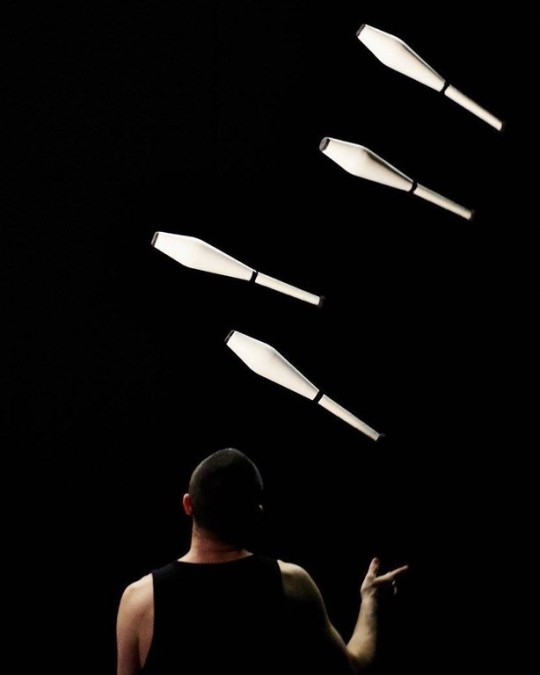
It sounds fantastic! You’ve performed in London before, but how do you feel about being in the Mime Festival? I’m very excited to be there. Whenever I’m in a festival and can look at all the other shows in the programme and think, ‘I want to go to every single one of these’, I feel at home, and think, ‘Great! I’m in a like-minded space. I’m really happy that my juggling is fitting into a world that I made it for, and I know that the type of audience that goes to these types of shows will see the juggling in the same way that I do’. And I really think that’s it’s a good home for the show. I’m very happy to be part of it.
Can pick out, from your lengthy career, any particular highlights? I really remember the first time I performed Zebra was in Paris. I’d been working on it for a few years and I really wasn’t sure how it would go, because I was like, ‘Are the people going to respond to this? I’m trying to make something quite different. Is it going to work the same way for them as I see it?’, because sometimes when you’re in your own work for too long, you can’t see it anymore from someone’s eye that’s never seen it before and yeah, when I came offstage and everything had gone so well…
I was also very nervous because the show was all run on vinyl records; there are times when I’m like, throwing them, and bouncing them and if I break one, that’s it. That’s my little twist on the idea of jugging being dangerous, because it’s often dangerous for the juggler, juggling chainsaws or whatever, and now I try to work very closely with the objects and I want to do juggling that a ball would want to do. Or if I was a record, how would I like to be juggled? And now there is danger for the object [laughs]… it could break, and danger for the entire show. But it went OK, I didn’t get so nervous that I broke a record. It went great. That was one of the best feelings I’ve had.
I also make juggling films. I often work for a few years at a time making juggling films that are kind of like skate films, where I collect the coolest tricks and find themes to edit them around and I release those every couple of years for the juggling community. My most recent one is called Gumball, which people can see pieces of on YouTube. When I released that it had been in the works for almost three years and that was one of my highlights that I could make film-specific juggling and had a lot of tricks that I’d never seen done ever before. Yeah, it was like a big expression of who I am and this is how I believe it can be and, here we go, I hope you like it. Sending something like that out to the world feels great.
youtube
Wes appears in Zebra at the Southbank Centre’s Purcell Room from 24-26 January 2020 during the London International Mime Festival
Picture credits: Headshot, Pierre Feniello. Zebra in order, Avi Pryntz-Nadworny; Brend Van Kerckhove; Florence Huet; Luke Burrage; Sonia Sleurs
Wes’ website
For tickets to Zebra, click here
London International Mime Festival, what’s on
Twitter: @WesPeden; @MimeLondon; @southbankcentre
Follow @TheWidowStanton on Twitter
#wes peden#juggler#circus interview#doch stockholm#London International Mime Festival#southbank centre#Gandini juggling#zebra
0 notes
Text
Mick Jones & Lou Gramm Explain How Diana Ross Inspired 'Jukebox Hero The Musical'
Foreigner is one of those bands whose songs you know, even if you don't own one of their albums. Their success in the late '70s and '80s amassed sales of some 75 million albums and netted nine top 10 hits on the Billboard Hot 100, including one No. 1.
Lou Gramm was the inimitable voice and some-time writer, and Mick Jones the guitarist and main songwriter. Gramm left the band in 2003 (replaced by Kelly Hansen), returning recently to play the odd 40th anniversary show, but is in Toronto, alongside Jones, to see the songs in another form: sung by the young cast of Jukebox Hero The Musical, the title of which is from the pair's smash from 1981's 4 album.
The theater production, spearheaded by Jones, managers Phil Carson and Stewart Young and jukebox theatre promoter Jeff Parry, was workshopped last summer in Alberta and had its world premiere this week in Toronto. It closes Sunday night.
Other Foreigner hits woven into the two-hour-and-20 minute show are "Cold As Ice," "Dirty White Boy," "Double Vision," "Feels Like The First Time," "Head Games," "Hot Blooded," "I Don't Want To Live Without You," "I Want To Know What Love Is," "Say You Will, "That Was Yesterday," "Urgent" and "Waiting For A Girl Like You." See, you know them, right?
It was singer Diana Ross who planted the seed of a musical decades ago based on "Juke Box Hero." Jones wrote the lyric after he noticed a kid in Cincinnati waiting five hours in the rain to meet Foreigner and was ushered backstage to watch the show, but Jukebox Hero The Musical isn't about a starry-eye Foreigner fan.
The book was written by Dick Clement and Ian La Frenais, whose credits include The Commitments and Across The Universe, and tells the dual story of a dying steel factory and two musician brothers feuding over a girl; one leaves and joins the army (Mace Perry, placed by David Michael Moore), while the other leaves and becomes a rock star (Ryan Perry, played by Geordie Brown).
It is directed by Randy Johnson (A Night With Janis Joplin), choreographed and staged by Parker Esse (Shaw Festival's Me and My Girl, Grand Hotel), with music direction orchestration, arrangements and incidental music by Mark Camilleri (Celine Dion, Sting, Eric Clapton, Andrea Bocelli).
Billboard sat down with Jones and Gramm in Toronto before the world premiere. Gramm, who only found out about the production six weeks ago, was less chatty, but we did find out about his plans since retiring from solo touring.
What were the circumstances that led to Diana Ross suggesting "Juke Box Hero" could be a musical? I wouldn't think Foreigner and Diana Ross crossed paths a lot.
Jones: It wouldn't have been a bad combo actually, I have to say [laughs].
Where did you see her that she made that comment?
It was in Atlanta. We were both traveling back to New York and we were in this little VIP area and it was just us in the room. I think it was just pre or post The Wiz [1978]. She was getting involved in theatrical production and out of the blue, she said, "You know, you have a great song. It could work as a musical. It's great idea." It was "Juke Box Hero." I thought, "Wow, she knows that song."
Gramm to Jones: Did Gene [Simmons] tell her that?
Jones: I'm not sure. Did she cover it, you're saying?
Gramm: No, no, I was wondering if Gene Simmons…
Jones: Oh, they were together at that point.
Gramm: Yeah, yeah.
Oh, so maybe Gene played it for Diana?
Gramm: Maybe.
I'm sure there's been many fans over the years that have waited five hours in the rain to see Foreigner. Lou, do you remember this guy being brought into the venue, soaking wet, to watch the show from side stage?
Gramm: I don't actually, no.
Why did he inspire the lyric, Mick?
Jones: This just stood out for me. I took pity on the kid because he had all the albums and had all the stuff to sign and he was drenched to the skin. I invited him back and his eyes went [opens eyes wide, like the lyric 'saw stars in his eyes']. I remember it clearly because it was a little moment, an emotional thing. And I identified it with it a bit.
In what way?
Jones: The dreams that I had when I was that age. I was never one to wait outside the stage door, but just the spectacle, bringing that kid in and we showed him the works. We had him on stage with us. He was on the side of the stage, and he was living the dream.
You've never heard from him since, but there's currently a search to find him. No one has stepped up and said, "It was me? I stood outside in the rain for five hours and you brought me backstage and onstage"?
Jones: Maybe he doesn't even remember it [laughs].
Have you put word out in Cincinnati?
Jones: Yeah, but I haven't heard much about it to tell you the truth. Would be kind of cool [to find him].
Gramm to Jones: Are radio stations looking?
Jones: Yeah, I think so.
How do you start on a project like this? Do you say, "Here is our catalog"? Did you talk to them about what the lyrics were about?
Jones: I had known Dick, and Ian was a personal friend of mine. We got into the songs a bit, trying to build the big picture of where it was going and what the story would try and portray. It wasn't the verbatim story from the song. It was taken into another area. It felt in some way that it really represented us and they were sensitive to that. I knew them quite well and socially and they'd known me.
Do you like musicals? The rock world and the musical theater world are quite separate.
Jones: I go occasionally. I saw the ABBA one, Mamma Mia. I went to see Rock of Ages; there was something about it that exaggerated too much, trying to get reactions.
Gramm: I saw that too. I saw Phantom [of the Opera] and it was spectacular.
Did you have parameters? Don't make our songs too "show tuney." Would that be job of musical director?
Jones: Yes or the interpretation of the actor who is singing. All those things go into account. I'm sure as [the show] proceeds — and hopefully it gets a life of its own — that will develop even more. There's quite a lot of dialogue in it too. The music is the principal.
Mick, you were born in Portsmout [UK], which was an industrial town and naval port. Sting has his musical out now in Toronto, The Last Ship, about the demise of the shipbuilding industry. Does the story of a dying steel factory resonate with you and your family background?
Jones: Yeah, a lot of my family were working class people. And I keep aware of things. I see what's happening in America, for example, what's happening all over the world. There's a tremendous amount of unemployment and nobody seems to have the answer to it. You've got people that have worked 35, 40 years in the job that is their family, and suddenly it's torn apart at that point in their lives when they deserve to be enjoying it. They're victims of corporate greed, the whole capitalist corporate thing that we live in. We've never been a political band. We've never written protest songs [but] I think it's important.
What's changed since the workshop production of the musical in Alberta?
Jones: There's been song additions. One that the director and the producers heard that had not been presented but was on an album that we released a few years back [2011's Acoustique & More]. It was a song ["Save Me"] that I wrote with my step-daughter Samantha [Ronson]. She's a great writer and lyricist. And as soon as the script-writers and the producer heard it, they said, "It's gotta be in the show." It was written in a pop vein, and then when the band got hold of it and the arranger, it completely changed. It's a very poignant part of the show now.
Are there plans to take Jukebox Hero to other cities or even to Broadway or Off-Broadway?
Jones: Obviously, that would be a dream come true. I hope it's going to resonate with people. From what I've seen already, it seems to be accepted. Boy, if it hits Broadway, even Off-Broadway, I'm open to that.
This is a great way for these classic songs that people know — even if they don't know they know them — to get more life.
Jones: That's an interesting thing because over the years we weren't a band that was plastered over MTV all the time. We never wanted to take that kind of direction. We weren't in the glossy magazines so much.
Gramm: Where the image was more important than the music, right?
Jones: In a way, we were quietly very successful. Very often, when people listened to the radio and they hear the songs, they don't remember necessarily [which band it is]. They've got it a little choice of about four maybe — Journey, maybe Boston who were around when we first started, but we have to remind them. Once they hear the first chord, they think, "Oh my god, is that them?"
Jukebox Hero isn't just for your fans. It exposes your music to theater goers and potentially to a newer generation — most of the cast weren't even born then — to revive the catalog or get more juice out of it.
Jones: It is our living. You have to be aware of the opportunities to keep the royalties coming in and all the other responsibilities we have. It's a job, you know? It's our careers and what we do.
Lou, is it true that you're not going to be touring with your solo band anymore?
Gramm: Yes.
Was that spur of the moment when you made that announcement this past December or had you been thinking about it?
Gramm: The announcement was spur of the moment, but the decision had been made a while ago.
Why is that?
Gramm: I'm just at the point now where I'd like to turn my attention to people I love and other things that I enjoy.
What else do you enjoy doing?
Muscle cars.
Buying or fixing?
I have a small collection. I enjoy fixing them and driving them. It's been a passion of mine since before I was old enough to drive. And in Rochester, there's a very short time where you can drive cars where it's not snowing and it also happens to be a time when we're touring the most. So I want to put that time aside.
I read that there's a possibility that the two of you might work on new music, that demos have been sent to each other?
Gramm: Oh yeah. There's a possibility for that. For sure.
Jones: Yeah, definitely. We've been so busy tell the truth. It's pretty exhausting. It's just finding that time when you can take a week somewhere, and even five or six days, just to get together and try and think back to where we were heading with the ideas. I listened to a couple of tracks last week and I definitely heard some ideas in there that are quite valid.
Source: https://www.billboard.com/biz/articles/8499676/mick-jones-lou-gramm-explain-how-diana-ross-inspired-jukebox-hero-the-musical

0 notes
Text
No excuse at all
It would be silly to announce that 'theatre is dead' (although it is fair to note that it is far from the dominant artistic medium in 2017). I have seen work - David Leddy's Coriolanus Vanishes springs to mind - that affirm the dynamism of theatre, and while I can't say that I enjoy everything at Buzzcut, the festival has an admirable vibrancy as well as some exciting performances. It would probably be equally silly to say criticism is dead, but after reading the reviews of Jane Eyre, I am not willing to say it is healthy. Produced by the National Theatre, this adaptation was a lazy chronological romp through a well-beloved novel that failed to deal with the problem of a romantic hero locking his wife up in the attic.
I don't want to be joyless about this, but having the abused wife wander about singing Cee Lo Green's Crazy isn't just a breach of taste: it is an abdication of moral responsibility. A love song about mutual dependency lacks the gravitas to accompany a house fire that ends in suicide. Perhaps because I am in a minority about this, I am raging about the National Theatre's Jane Eyre. It is one of the most tedious experiences that I have had in a theatre, and its version of 'the English Touring style' barely hides the witless dramaturgy that takes a romantic novel and converts it into a three hour long exploration of how thoughtless contemporary theatre can be. Let's start with the easy targets. Jane Eyre is about a romance between a governess - abused as a child by a vicious aunt and a religious schooling - and an aristocrat who has some dark secrets. One of these secrets is that he has locked his wife in the attic.
When the wife eventually escapes the attic, burns down the house and jumps off the roof, singing Cee Lo Green's Crazy is not a bold dramatical choice. It's a fucking insult, and an instance of how this adaptation repeatedly fails to think before it acts. For those not paying attention, being exotic and darkly sensual is not an excuse for locking away women. Second easy target: the ensemble came up with a
neat choreography to represent a ride in a carriage. So they repeat it. Three times. Yes, it was cool the first time, the way they all jogged about, pretending to be both passengers and the horses. But your production is three hours long. Couldn't you have just assumed the journey? And the length itself... the purpose of adaptation might be to reinterpret. Certainly, with a familiar text like Jayne Eyre, there are certain scenes they could be removed. A teaching scene, for example, doesn't need to followed by a conversation about the experience of teaching. I've got a train to catch, and I don't need a reminder of the protagonist's most recent action. The desire to round out Jane's character causes problems - having seen her at home, at school, teaching and travelling, her personality's development is fully explicable. Never mind it takes ages for her to meet Rochester (and, yes, the novel is centred around that romance): when he does turn up, his awkwardness and mystery is attractive because there is some dramatic tension about him. What has he been doing? Why is he so odd? Jane, meanwhile, is so clearly a product of all the activity the audience has spent an hour watching that she lacks any interest.
Oh - and just because a man pretending to be a dog gets a laugh, don't put it in every scene. Yes, we get it. Hilarious. But my rage is not directed at the company. It's directed at the critics who can't tell the difference between bog-standard theatricality and an imaginative direction. The show has received four and five star reviews for rolling out an over familiar bunch of tricks (abstract set like a 'climbing frame', characters pretending to be Jane's interior monologue). One duff production is no evidence that theatre is dead, but poverty of criticism is a worry: if this kind of performance is accepted without caveats, then what motivation do companies have to think carefully about the reasons for staging a play? Or it is possible that I demand certain thongs from a play, and this fails to provide them, making my opinion a valid one, but not quite as important as I am making out... from the vileblog http://ift.tt/2qPVkzU
1 note
·
View note
Text
A Rochester Ghost Story
OMG - he’s accidentally shot his fiancé!
Will the spectre of “Blanche-the-Fair” make an appearance at Rochester Castle?
This is a type of 'West Side Story' plot that occurred around 750 years at Rochester. It is a story of two men from warring ‘gangs’ who desired the love of one women, and that tragically ends with the death of a pretty young woman - Lady Blanche Warrene - and one of her suitors.
The story starts some 50 years previous, in 1215, with the struggle between King John and the Barons - that was in part played out at Rochester with the siege of the castle in October of that year.
One could perhaps regard the Magna Carta as a compromise agreement as it brought silence but no resolution to the underlying tensions between the Monarch and the Barons. It should therefore come as no surprise that about 50 years later, in 1264, Rochester was again engaged in siege.
At this time Rochester Castle was loyal to Henry III. Henry, as John before him, wanted more money from the Barons to fund a war; the scene was therefore set for what became known as the Second Barons’ War.
The Barons led by Simon de Montfort and Gilbert de Clare - a past suitor of Lady Blanche - decided to re-take Rochester Castle from the King and thereby take control of the bridge.
Responsibility for the defence of the castle fell to John de Warrene, who had made the castle his home, and the crusader known as Ralph de Capo - the other suitor for the affections of the beautiful Lady Blanche de Warenne, and the one to whom she may have been betrothed.
On April 16th, 1264, news reached John de Warenne that Simon de Montfort was heading to Rochester with Gilbert de Clare and a large army. Warenne offered his daughters, Blanche and Maud, the opportunity to leave Rochester for safety of his castle in Lewes. Both decided to remain in Rochester with Blanche even declaring she would, if necessary, wield a sword or use a bow.
The early attacks on the castle by Montfort’s troops were repelled. Stuck on the Strood side of the river Montfort decided to send under the cover of darkness a detachment of men under the command of Gilbert de Clare, to Aylesford. Here they would ford the river and then make their way, via Borstal, to Rochester where they could attack the castle from the other side.
On Good Friday Montfort staged another attack setting fire to the bridge and causing a plume of thick smoke to envelop the castle. The citizens of Rochester recognising the danger they faced put all their efforts into thwarting Montfort’s attack. As they gave chase to Montfort’s retreating men they left undefended areas of the City that they thought were invulnerable to attack - cue the attack by Gilbert de Clare and his men.
Here we definitely move from the historical record to the anecdotal - with chroniclers saying they only report as they were told.
Gilbert de Clare seeing the unprotected Lady Blanche on the battlements, cheering her men on, decided to press his attentions upon her. Perhaps because he was dressed in full armour she thought it was Capo, her fiancé, coming to join her. From down below and from within the heat of battle, Capo saw Blanche trying to defend herself from the unwanted attentions of Gilbert. Being an expert bowman Capo loosed a very accurate arrow towards Blanche’s assailant. It most certainly found its mark - but the arrow was deflected from Gilbert’s armour and fatally pieced the heart of Lady Blanche!
Another account suggests that about a week after the Good Friday battle, when Simon de Montfort was leaving Rochester, having been ordered to end his siege of Rochester Castle, Gilbert de Clare attempted to abduct Lady Blanche.
“Approaching the lady, who was intently watching the movement of troops, Gilbert came behind her, seized her by the waist, and, lifting her up, he carried her struggling down the wooden stairs of the Water Tower, while his men guarded the top of the steps.
“Putting his bugle to his lips, he blew three mots to attract the attention of the men on board the vessel, which quickly made towards the stairs.”
“The sounding of the horn also attracted the attention of Capo, while the clashing of arms upon the top of the stairs told him that treachery was at work. But great was his alarm on seeing the Lady Blanche struggling in the arms of a knight equipped like himself.” As in the previous account, Capo loosed an arrow that “after striking the armour of Gilbert de Clare glanced off and entered the bosom of the Lady Blanche.”
Capo pursued Gilbert and a furious combat occurred on the vessel in which Gilbert was trying to make his escape. During the fight Capo’s foot got tangled in some rope and whilst off-guard “the sword of Gilbert descended on his head cutting clean through helmet and skull.”
“Without a groan de Capo fell at the feet of his enemy.”
+++++++++++++++++++++++++++++++++++++++++++
It is the story of Lady Blanche’s death and perhaps her searching for her lover, that causes those who have seen a ‘Lady in White’ walking the battlements of Rochester Castle - on Good Friday - believe the apparition is that of Lady Blanche.
Having not witnessed the apparition of the ‘Lady in White’ I can add no more to the story - other than to say I’ve heard an account of a woman who, unfamiliar with the story of Lady Blanche’s demise, reported, on entering the castle grounds, that she sensed a woman had been attacked there, and then felt a sharp pain in her chest!
Based on the following accounts of two chroniclers/poets, the best time to visit the castle, in the hope of seeing Lady Blanche, would appear to be between 11pm and midnight - she may not be aware we now change the clocks - and on Good Friday. As Good Friday does not fall on a fixed date perhaps it would be best to attend every night between Good Friday, when Montford first entered the outer castle, and the 25th April when he left Rochester and the fair Lady Blanche may have met her tragic end.
The battlement on which Blanche may have been attacked could have been along the now Castle Hill. From here she would have been visible to Capo who would have been pursing Montfort’s men in the direction of the wooden bridge [positioned where the railway line now crosses the river]. She could have also witnessed from this vantage point the withdrawal of Montfort’s troops. However, another account suggests she was killed on the southern battlement [Boley Hill].
The ‘historical’ basis of this story is drawn from the “Third Siege of Rochester Castle” by Edwin Harris, published in 1902. Harris’s account was based on the prose of earlier writers - neither of whom were contemporary. Both describe the tragic events that led to the death of Lady Blanche. The first account, published in 1829, states, with a sceptical qualification, that Blanche can be seen leaning against the battlement on which she died when the Priory bell strikes midnight:
Mark well the southern battlement, for there Earl Warrene’s lovely daughter, Blanche the fair, Fell like a flow’r, which is by some rash hand Cut down, before its beauties can expand. Ann arrow ’twas, from noble Capo’s bow, That pierced her heart and laid the maiden low And it is said - (how true, we ne’er can tell) - Ever at midnight, when the Priory bell Proclaim’d that boding hour, the maid was seen Against the fatal battlement to lean! Anon. 1829.
There was also a song, to be sung in “an unearthly strain”, that provides details of Capo’s character and his adventures. It also describes the battle and the events that led to Lady Blanche’s untimely demise.
“Ah, me! that I, the gentle maid would cry, Should be by Capo’s hand thus doomed to die. Oh! fatal night, when real Montfort came With his vile host, these Castle walls to gain. It was by yonder hill the traitors lay, Incas’t in steel, on Friday Holy day! But when the sun had gone his daily round, And night had cast its gloomy shades around: Then, in array ‘gainst Henry’s crown, they form, And vainly tried these solid walls to storm. But lordly Warrene, my most gallant sire, Did with true courage his bold knights inspire: And they with frightful carnage often drove False Montfort’s men, as in the ditch they strove Our goodly Castle’s outer-works to take, And in our walls a fatal breach to make. Yet oft they came, and fierce the combat rag’d, When knight to knight, and man to man engag’d. The spear, the sword, the arrow, and the dart Oft found their way to some bold warrior’s heart. Ah’ mothers, maids, and wives, with grief can tell How many valiant men this night there fell. For oft as they dared our high walls t attack, So oft were they with slaughter driven back; And were pursued: but fatal pursuit this! It took from me the joys of earthly bliss! For Capo chas’d the rebels in their flight, And to the grave sent many a gallant knight! For he was brave; yet had a heart most kind. And he excell’d in person and mind All gentle knights: for great was he in fame, And from a stock of noble lin’age came. Tall was his stature, and his fine form’d face In beauty shone with ev’ry manly grace! I lov’d him well! and was by him belov’d! And our fond loves were by our friends approv’d. Ah! oft we met by moonlight and unseen, Within good father prior’s shady green! And there have sat, whilst he would tell What ills on him in Palestine befell: What he endur’d among the cruel Moors, When shipwreck’d was upon their bar’brous shores. Indeed, his sufferings would good Christians move Their soles to pity, and their hearts to love. But ah! these scenes I ne’er no more can see! Yet, for these scenes, no rest’s in store for me! No unction I, that holy church ordains, Receiv’d, to soothe my purgatory pains! For in my sins, me, Capo’s arrow slew - Tho’ Capo, when the bow-string pull’d, ne’er knew That it was destined for his mistress’ breast, To slay the maid that he so oft cares’d! For thus it was: when he by zeal was led To chase the rebel Montforts as they fled; When far he from the Castle walls had gone, And found himself amidst his foes alone! Then, to retrace his daring steps he tried, And thus, alas! too fatally espied, Mounting upon our outward walls, a foe, Who to destroy he bent his erring bow - For here it struck! - Thus said, a horrid scream. The maid would shriek! - whilst from her heart a stream Of purple blood would down he blossom run! Then disappear before the rising sun!
Thus ancient chronicles are records say, - But then, their truth, who likes to doubt them may; We ne’er shall try to turn the sceptic mind, We merely state the facts as them we find.” Anon.
Another of Geoff Rambler's City Ramblings. March 2017.
0 notes
Text
Universe Point After Afterword: Part 1
When I initially sat down to write Universe Point, I envisioned the final chapter being about the events surrounding the first time I stepped onto the fields at nationals after twenty odd years of playing this crazy sport. But as I reached the final stages, I realized that the book wasn’t actually about me. It was about ultimate itself and whether or not I actually got to play at nationals was weirdly irrelevant. (Thus pushing aside my ego for what I believe was the first time ever) But after experiencing nationals (grandmasters) for the first time, I felt compelled to write that final chapter anyway because it was such an amazing experience. Skyd has graciously given me a space to share that chapter. Hope you enjoy.
Universe Point – After Afterword
Sometime in the spring of 2011, (around the time I started writing my book) I received a message from my old friend Black Tide Matt. It basically went like this:
“Hey Cramer, are you 40 yet?”
“Uh….I’m only 34.”
“Damn it. I was hoping you were old enough for grandmasters.”
Fast forward to 2012.
“Hey Cramer, are you 40 this year?”
“I’m 35.”
“Damn it.”
And 2013.
“Hey Cramer are you….”
“I’m 36. I actually crunched the numbers and I’ve found that so far I’m aging at damn near the same rate as other humans,” I responded. “If that pattern holds, it puts me at a definite yes around 2017. I’ll let you know if anything changes though.”
He asked in 2014, 15 & 16 anyway just in case I’d made a radical discovery about the accuracy of my birth certificate until finally 2017 rolled around. This time he didn’t have to ask. I sent a preemptive strike on January 1st.
“Matt, I’m going to be 40 this year and yes I will play on your Grandmasters team if you still want me.”
When he said yes, I floated to the ceiling. His team, Endless Sunset, out of San Diego had made grandmasters nationals five years in a row and were pretty certain to do it again. Having been injured at my only chance to play at (college) nationals back in 2003, the mere thought of being on those fields revved me up for weeks even though the tournament was damn near eight months away. So I set out to do what all grandmasters players do in the months before a big tournament – try not to get hurt. Which at 40 can happen during any life event – doing squats, swinging kettlebells, going for a run, watching hockey, putting on pants, opening a drawer, reading stuff– you’re pretty much dodging grenades at every single moment.
To keep my ultimate skills game ready, I played in the Wednesday Night Pittsburgh Summer League on a fluorescent orange team that was either named Cutie Tang or Scorange or Not a Deer depending on the week. In our final game before I was set to fly to California for regionals, we were marching the disc downfield on universe point when I came across the back of the end zone wide open. A floaty backhand went up that allowed my defender, Pittsburgh Thunderbirds play-by play-man and long time ultimate stalwart Matt Weiss, to catch up. Somehow my age-depleted vertical allowed me to go over him to make a sweet catch along the sideline, picking it and stretching to get my toes down in bounds.
When I was five years old, my mom sent me to a gymnastics class where the instructor said, “You should stretch every day.” So I did. And I needed every bit of those thirty-five years of flexibility training to ensure that bits of my knee didn’t end up in the bleachers when Weiss rocked me an inch before my cleats hit the grass.
With all of his weight still pressed down on my legs, Weiss extended his hand to me with panic in his eyes. “Oh shit, Cramer. Please tell me I didn’t just take you out on the last point before regionals.”
“Hold on,” I said, pulling my leg out from underneath him and flexing it. “Nope, I think….yeah, I’m good,” I said trying to hide my surprise.
“Oh thank god,” he responded, rolling off me and flopping to the grass.
It may have taken a minor miracle, but I was going to be healthy headed to….
The next day at work a concrete block I was smashing offered a lot less resistance than I anticipated. My sledgehammer crashed through it, ricocheted off a railroad tie and crushed my left hand against a fence post. I was headed to California with a broken middle finger. Life is an asshole.
So that Friday morning after a cross country flight to San Francisco, lunch with my ex-teammate Iron Mike, and a surprisingly cool drive through the mountains northeast of the Bay Area, I arrived in Sacramento to meet my new teammates at a super sick AirBnB with thousands of bedrooms, a refrigerator bigger than my kitchen, and an in-ground pool. It was the first sign that grandmasters was going to be a rather large departure from college and club. For the first time ever my teammates obviously had some cash to spend – since ya know, we’re all middle aged now and (supposed to) have careers and shit. This was not the “cram eight guys into a seedy Motel 6 in downtown Rochester” experience that I was used to. I slept in a real bed that I didn’t have to share with anyone else. Let me repeat. 2,000 miles from home – slept in a real bed – by myself – in my own room. What was I, playing at Wimbledon? It didn’t make sense.
Black Tide Matt and I realized that even though we’d chatted a bunch on social media, we hadn’t actually seen each other in going on fifteen years. It was an awesome reunion. He looked basically the same and though he told a lot less Black Tide stories during the weekend, I did arrive at the house to find them screening “I Bleed Black,” (the old UCSB documentary) on the flat screen in the livingroom.
“Ya know I used to play for…”
“We know, Matt. Some of us were your teammates.”
A couple other great dudes were staying with us at the house that weekend as well. Matt’s co-captain, Ryan, was as California as it gets – tall, wind-swept blonde hair that didn’t move, and this unassuming yet somehow vitally important to the economy kind of vibe. Bryan was a lanky west coast surfer with glasses, who from a distance could’ve passed for the kid who does the morning announcements at your local high school. Guillermo was another of our out of region guys, a speedy Argentinian soccer player from Memphis who at 40 looked like he could still be playing on Lionel Messi’s wing.
And then there was my old buddy Brody who’d founded the University of Pittsburgh’s college team back in the late 90’s. Many ultimate players would recognize him on sight from his trademark floppy hat and the bazooka-sized camera he lugs around taking pictures at most national tournaments. We’d played against each other a ton in summer league in our late teens and early 20’s, but had never been on the same team. So when Black Tide Matt asked if I knew any other top tier out of region players, I put the two of them in contact – excited at the possibility of sharing the field with him. Later on, it could easily be argued that it was my most valuable contribution to Endless Sunset.
Our games that day were at noon, 2:00, and 4:00, right in the heat of the day, a fact that loomed over us as we drove to the fields on an already broiling morning.
“What’s it saying?” I asked as Brody checked the weather on his phone.
“Ninety-five and sunny.”
“Ninety-five? Maybe uh…..they’ll be wrong.”
Turned out I was a prophet. The high reached 100.
So our warm up consisted of a bunch of guys who really wanted to play ultimate – just in Vancouver or Anchorage or somewhere that wasn’t Sacramento on that particular Saturday. Guillermo and I did our yoga and stretching routines in the skinny shadow of a light stanchion while other guys chugged water like it was beer and tried not to spontaneously combust. As we were called out to warm up, a lot of dudes suddenly remembered they still needed to put on sunscreen in the tent or go hit the pisser. It felt like the sun had crept up to where the moon hangs out. It was neck baking.
But I hadn’t flown in from Pittsburgh to sit in a tent, so I put on the kick ass blue, orange, and every other color known to man Endless Sunset jersey that I was borrowing for the weekend and ran on the field with our defensive line. Our first game was against what felt like a pickup team out of Los Angeles. They had a few good players but not a lot of numbers and we coasted to a 15-4 victory.
We huddled up before our next game against a team called Old Growth out of San Jose. “This is the game we need,” Black Tide Matt implored us. “If we’re a nationals caliber team, we thump these guys. It’s hot, but that’s no excuse. We know what to do, so let’s do it. Sunset on three. One, two, three…”
“Sunset!”
I came out as hot as the air temperature in that game. We were up 1-0 when I went in on defense. We forced a turn on the goal line and set a vertical stack. From the back I saw that our handler had overshot the guy he was aiming for. I bailed him out, racing over to catch it for the goal, my first with Endless Sunset.
Feeling great, (even with my broken finger) I stayed on. About halfway up the field, I forced a high swilly throw that we easily knocked down. As I jogged across the field to my outside cutter position, I was unexpectedly open and whoever picked it up shot a crossfield flick way out in front of me. I slid to catch it with a guy on my back, then popped up and floated a high release flick over a defender’s fingertips for our third goal. I only rested for a point before coming back in to catch the goal that put us up 5-1. At that point, I was obviously feeling pretty confident. I was playing solid D and on our first five points, I’d scored or assisted on three of them.
Then just before halftime came the point that almost sent me back across the country in a body bag. I was feeling awesome as I went out on D yet again. Old Growth worked it the whole way down the field before turning it just outside the end zone. I started to sprint deep and…..we turned it damn near immediately. I hauled ass back to cover my guy and…..they turfed the first pass. We worked it halfway up the field and overthrew a deep shot to the end zone. After four turns, the point was getting a little long for a bunch of old guys in the heat. I believe an automatic text went out to every EMT in greater Sacramento that they should be on alert for a pending mass casualty incident.
Old Growth brought it to the goal line and my guy cut in. I stuck with him and shut down the passing lane, then jumped inside for a hopeful poach before turning and following my guy deep down the middle. As I was chasing him, OG put up a long outside in flick down the sideline that I turned and hustled for, backing up my teammate, a skinny D hound named Dennis. He knocked it out of bounds, rendering my help completely needless so I turned and once again focused on offense.
In grandmasters at the age of 40, you’re actually considered young. And the problem with being young and comparatively big, fast, and athletic is you’re still expected to do big, fast, and athletic things. Unfortunately your body is no longer 19. It’s just not 49 yet. And what I found on that point is that there’s a huge difference between 19 and “not 49 yet.”
After the turn, I cut in and didn’t get the disc, so I released upfield. The guy guarding me was heaving breaths like a wounded gorilla. His hands briefly went to his hips, a sure sign I had him beat. At midfield I accelerated. Three quick steps and I was streaking past everyone up the sideline. The thrower saw me. It was going to be an easy…..
The only way I can describe what happened is that my legs just….shrunk. It was like in high school when the teacher handed out a test that was unnecessarily difficult and you pushed it aside and went, “Yeah, screw this.” That’s what my legs did. I saw it later on video. One second I’m a serious athlete sprinting down the sideline and the next I’m a cross between a scarecrow and a monster sewn together from random body parts. I didn’t lay out so much as collapse. The disc hit the ground an inch from my outstretched fingers. It was the last time I could reasonably say I felt “fine” that day.
Based on that debacle, a whole bunch of guys who I’d just met that morning began to give me running advice.
“So Cramer uh….you really need to work on your stride. That was the most awkward run I believe I’ve ever seen. We thought you pulled both hamstrings.”
“Nah, my stride is fine. I was just dead at the end of that point.”
“Yeah but your stride though. You’re like an old robot out there. Like a rusty one that’s been in a shed since the 50’s and needs lots of repairs.”
“Seriously though, my stride is ok,” I said. “There were five turnovers on that point. Five.”
“No offense. I’m not trying to be critical. You just need someone to show you how to run. Because it’s obvious you’ve never been taught proper technique.”
“I was a runner in college. I know how to…..it’s a hundred degrees and I ran up and down the…..” The argument wasn’t worth it. “Yeah, I’ll try to work on my stride.”
I played sparingly in the second half as we got past OG rather easily, 15-6. But though I guzzled more water than actually fell on California the year before, I still couldn’t catch up.
The two words that would describe my next game against Shadows (the top seed) out of San Francisco would be dizzy….and ineffective. I played four points, realized that I most likely had a minor case of heat stroke and then was told I should probably sit out the second half.
“We’re going to need you for tomorrow,” they told me, which was a really nice way of saying, “Dude, we’re going to let someone who isn’t sucking as hard play a little more. Cool?”
That night, our team and a bunch of the LA dudes got some beers and chilled in the pool. Black Tide Matt ordered enough pizza that the local Dominos thought it was a prank, and we all chilled watching the sun set over the palm trees talking of our ultimate origin stories – of how we’d discovered the sport in the 80’s & 90’s back when the sport wasn’t even “fringe.” Nobody got plowed and jumped off the roof into the pool. Nobody puked. Nobody got “a tiny bit confrontational.” It was just a chill night. Grandmasters style.
After a gallon of chocolate milk and what felt like fifteen Gatorades, I was almost back to normal the next morning. It helped that the games started at 9:00AM before the sun decided to burn off the atmosphere. In the 2 vs. 3 game against Old Growth, I got a hand block on the first point, which my confidence desperately needed. We played a solid game and when Guillermo caught a little backhand in traffic over the goal line and raised his hand in the air signifying our 15th goal, I pumped my fist and smiled, damn near skipping onto the field. It assured us 2nd place in the Southwest Region. After 22 years, I was at long last going to play at nationals.
The final against Shadows was a big test and though both teams were assured a trip to Denver for the big tourney in July, Sunset had apparently never beaten them. So it was a huge deal to my teammates. The full name of their team was apparently Shadows (Of Our Former Selves). And damn if they were only shadows of their former selves, it was scary to imagine the players they were at 25. I’m (arguably) the fastest over 40 ultimate player in Pittsburgh, a decent sized city with a great ultimate scene. And they had fourteen guys at minimum who were as fast as I was. As a side note, I’m no longer convinced that the fog that rolls into the Bay Area each day isn’t just a cloud of human growth hormone.
Unlike the day before, I felt pretty good as I took the field against them. Late in the first half I laid out to snag a low throw, then popped up and saw Guillermo fake in and take his guy deep. My high release flick hit him in stride to put us within 6-5.
After my biggest moment of the tournament so far, I stormed into the tent and high fived my teammates. “See…see, I’m a pretty good player when I know where the hell I am!”
Then on the next point Defensive Dennis had a sick layout along the sideline to start a break that tied the game 6-6. It was looking like we were going to hang with and perhaps even upset the beasts of the Southwest.
I went in on the next point and glued myself to my guy, not letting him go anywhere without my tattoos in his face. We forced a turn. Feeling confident, I faked deep, stuck my heel in the ground and left my guy behind me. Our handler put up a flick that maybe needed some more zip, but it didn’t matter. I was going to catch it and start the break that was going to put us up 7-6. There was no other possibility.
I just assumed the dude who was guarding me was old and would never be able to recover from the juke I threw on him. And you know the saying about what happens when you assume – it makes you look like a goddamned lazy idiot when you don’t run through the disc and allow your guy to sneak past you and tip it away. (I may have modified that saying slightly to fit the circumstances.)
After that, Shadows went on a four goal run and we never quite recovered losing 15-8 in a game that I’d definitely helped squander. Though disappointed, we came together with the guys from Shadows in a great spirit circle after the game, laughing and shaking hands.
“See you fellas in Colorado.”
Being in that circle with a bunch of athletes who now had gray hairs, a little less muscle, and a few more ailments, I could definitely appreciate the quote at the bottom of the Shadows uniforms.
The older we get, the better we were.
It’s true. I’m far better at 22 now than I ever was when I was actually 22. I think my vertical from back then is up to 70 or 80 inches. My forty yard dash time comes in around four flat. I once scored 17 goals in a game that ended 15-1.
The older we get, the better we were.
It’s the one great thing that us ancients have on the new wave of players who find themselves promoted in slick ass Callahan videos and ESPN live streams. They’re always going to be exactly as good as their actual performance. They can’t stretch the truth. So when I start feeling slightly depressed that the pro leagues and television contracts missed me by half a decade, I can always smile at the young’uns and say, “You should’ve seen me way back when, junior.” And laugh because they won’t be able to verify shit.
You kids may have your Evan Lepler interviews and your Sportscenter Top Tens, but we have legends. Which let’s face it, I’m going to try (and likely fail) to convince myself is somehow cooler.
I spent the entire plane ride home in a middle seat waiting for the leg cramps I knew were on the way. Honestly, it felt like my own hamstrings were stalking me. Somewhere over central Indiana they finally jumped out of the bushes, frightening the hell out of the business people on either side of me. If I were on top of my game, I’d have patted my pocket and said something along the lines of, “Damn it Brutus, quit scratching daddy! Little guy sure hates flying. But that’s squirrels for ya, am I right?” As it was, I just got to chuckle uncomfortably as they both began desperate searches for their headphones.
Uncomfortable plane ride aside, it had all been worth it. At long last, I’d be playing in the tournament that had eluded me for over two decades.
Universe Point is available now on Amazon!
The post Universe Point After Afterword: Part 1 appeared first on Skyd Magazine.
from Skyd Magazine http://ift.tt/2fkAGmP
0 notes
Photo

Jesse Thayer
Set Carpenter, Roger Waters 'Us and Them' Tour
Photographed at T-Mobile Arena, Las Vegas, Nevada
June 16, 2017
>A couple days ago I sat down with my friend Jesse Thayer, a Los Angeles-based set carpenter who works on arena and stadium-sized concert tours. We talked backstage at T-Mobile Arena in Las Vegas, Nevada.
--What are you up to right now?
“I’m on the Roger Waters ‘Us and Them’ tour, I’m a carpenter. I like to use the term ‘Staging Technician’ sometimes because it sounds more official”
--Where did you grow up?
“I’m from Rochester, NY originally.”
--So how did you get to this point, growing up in Rochester? How did you start into this business?
“As a nineteen or twenty year old, I started pushing cases at a local amphitheater called Darien Lake. At that point it wasn’t a union building, so they hired us out - we had a great time, a lot of good people there. As things do, one thing led to another thing, and I pushed cases somewhere else... Domino effect. Took a long time I feel.”
--Did you stay in Rochester for a while?
“Yes, I want to say I stayed in Rochester until about 2011. I briefly moved to Nashville, which was fantastic, great place to live. Then Wilkes-Barre, Pennsylvania, and finally Los Angeles in 2013”
--Were you working locally still, or were you touring at that point?
“In Nashville? I was touring. I started touring in 2006. One of the guys I met at Darien Lake, Frank, needed a replacement out on Mötley Crüe tour.”
--Good first tour
“Yeah, oh man, I did three of them. Lots of debauchery. Good times.”
--Have you done other jobs in the business along the way?
“I worked as a supervisor for a labor company for a lot of years, but still in the business - the low end of the business, but we were involved and got free tee shirts and backstage passes. Lots of stress. But it was a lot of fun. Stressful years, but good years. I did that until 2002, and then I wen to work for a staging company in Wilkes-Barre, Pennsylvania (Mountain Productions) for about five years. That was a good experience too, good people, I enjoyed that part of it and what I was doing. I had always dreamed of working in the music business, even in high school - one way or another. I think initially I thought I was going to work as an (audio) engineer in a studio, but just knew I wanted to work in the music business. It’s what I was passionate about.”
--What was it about the music business, are you a musician yourself?
“No, I’ve never been ambitious enough to pick up an instrument, but I do love music. In my house we have music playing all the time. We have to have a soundtrack to our lives. If I’m in the car, there’s music playing. One of the things I like doing is just walking around with my iPod and just taking in cities.
I worked as a DJ for a little while at a radio station, which was great. Worked at a record store at the same time. It was a college radio station, and we didn’t get paid, but we got free CDs and some swag. I was perfectly content getting free CDs and getting on the guest list at clubs when I was 23-24 years old.”
--Did you have people you learned from as you worked your way up in the business?
“Boy, that would be a long list of people. That would take me a long time to put together. Getting up in age as I am, I always look back to key people. I try and recognize the fact that certain people really made an impact in my life or made a difference and talked me into doing something, or to put my name in for something. There definitely are those people who effected my life, for sure. In every different chapter of my life, whatever I was doing, there was always somebody that I was close with thatI learned from. As a DJ, working at Darien Lake, at Mountain Productions, working as a carpenter. I’m learning all the time. I could point to a couple instances on this tour where I’ve learned to do things that I’ve never come across. I need to retain more. I have an enormous amount of useless information that mostly has to do with music and 80s TV shows, I suppose”
--What are some of the standout tours you remember working?
“I am so lucky, there haven’t been many bad tours. I met my wife on Tina Turner, which was a big one! Which is funny, because we barely spoke the entire tour, and then we ended up getting married.
There was a Mötley tour that was the most fun, and I say that because it was a full Mötley tour. We had toured with Aerosmith in 2006 and we were the support act, touring with two trucks, almost nothing. We got the stage at like 5:30 at night, and we were off the stage by like 9:00, packed the trucks by 9:30. That was our day. On this particular tour, we were doing sheds, amphitheaters. The band (Mötley Crüe) didn’t have dressing rooms, only Aerosmith, so we had star trailers that we parked in a square in the parking lot. In the middle of the square was a tent, and in the middle of the tent was a stripper pole. That was pretty much our after-show every night, and Tommy Lee would DJ. It was a lot of fun, not a lot of people - two busses. Really fun tour.
Justin Timberlake was great. I did the Future Sex Love tour. Justin was a lot of fun because he was always around, it was a loose tour in that way - he hung out with crew a lot.
One of the first shows I ever did was for U2, not as a touring person, but as local labor. Just the fact that I could get to the point that I was working for the band was a huge accomplishment for me.
This tour too. I’m lucky to be on this ‘Us and Them’ tour, but I got to do ‘The Wall’ a couple years ago with Roger (Waters). The very first show I ever did was Pink Floyd in Cleveland - the ‘Division Bell’ tour. To be able to now work for Roger, and come full circle is great. To see Roger, and he knows who I am and says hello... It’s a very cool thing. I’m very lucky.”
--What do you do with your down time on tour?
“Photography, I try and do as much as possible. On my days off, I either go record shopping, or I’ll take my camera out and walk around doing street photography. Especially when we do cities in Europe. It’s hard not to take your camera out when you’re in Venice.”
*I should take a moment to mention that Jesse is a very talented photographer, and his work can be seen on his website, as well as some images of his on the Foo Fighters website. There’s a link to his site and his Instagram feed at the end of this page.
--What’s your plan after tour life, or are you a lifer on tour?
“I like to take things one thing at a time and let things happen as they happen. I’ve been really lucky the last few tours to be able to shoot (photos) during the shows. I could see doing that. It’s become a complex thing (as a touring concert photographer), but I could see doing that. Maybe my wife will stay really busy, and I’ll stay home...”
--What are some of the things you’ve learned, pearls of wisdom from the road?
“Time moves by faster than you think. Try and take it slowly as possible, and try not to miss moments. I think being able to tour is a great thing, but it’s also an enormous amount of work - long days. Just like any other job, you sacrifice something. We sacrifice time with our families and friends, and we’re always gone. I think, when you do get those chances, you take advantage of them and try to appreciate the time that you do have with the people that you have. The same thing with the music part of it, we work really hard and there are moments out on the road which are really amazing. I was right in front of Dave (Grohl, frontman of Foo Fighters) when he broke his leg, and in fact took his guitar from him when he was on the ground. Not a great moment for Dave, but an iconic moment, and I was lucky enough to be in that moment with them. I try and appreciate the amazing moments that this job has put me in.”
To see Jesse’s photos from on tour, check out his website at:
www.jesse-thayer.com
and Instagram: @jessethayerphotography
#ISM#insupportofmusic#set carpenter#tourlife#ontour#concert tour#roger waters#las vegas#t-mobile arena
0 notes